




By Matt Meduri
Suffolk County received a rare, yet potentially disastrous, development over the weekend: brush fires in southern Brookhaven and Southampton towns that sent smoke high enough in the air to be seen from across the Long Island Sound.
The fires scorched hundreds of acres in the Pine Barrens, shut down service on Sunrise Highway east of the Moriches, and became especially serious on Saturday night when the flames jumped Old Riverhead Road (County Route 31) near Francis S. Gabreski Airport in Westhampton.
By Sunday afternoon, the fires had been mostly contained while fire and rescue monitored active hot spots that were somewhat contained mostly due to vegetation-scarce barriers formed by roadways.
Continued on page 4
By Matt Meduri
After years of planning, construction, and preparation, the Forge River Treatment Plant is now complete and online.
The completion of the plant comes just six years after a 2019 referendum in which Mastic and Shirley residents voted overwhelmingly - a 414-71 vote - to create a sewer district to serve the area.
The Forge River Wastewater Treatment Plant began three years thereafter, which has long been seen as the basis for revitalization and water quality mitigation in the area.
on page 10




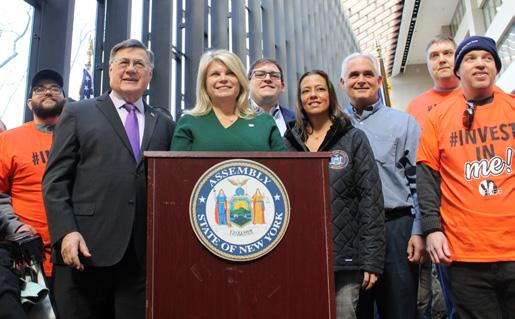







Published by Messenger Papers, Inc.
Thursday, March 13, 2025
Suffolk County Legislator Jim Mazzarella (R-Mazzarella) proudly recognized Wendy Gross as the Woman of Distinction for the Third Legislative District at a ceremony at the H. Lee Dennison Building in Hauppauge on Tuesday, March 4. Wendy was chosen for this recognition as a way of honoring her lifelong dedication to education, community service, and advocacy.
A lifelong resident of Shirley, Wendy Gross has devoted her career and volunteer efforts to uplifting her community. A proud William Floyd High School graduate (Class of 1984), Wendy earned her bachelor’s degree in music therapy from SUNY New Paltz in 1988 and a master’s degree in education in 1989. She has spent nearly three decades as an educator in the William Floyd School District, where she has been an unwavering advocate for students, families, and colleagues alike. Beyond the classroom, Wendy has demonstrated an extraordinary commitment to civic engagement. She has spearheaded annual Veterans Day and Memorial Day ceremonies, served on the Special Education PTA (SEPTA), and worked as a union representative for over six years. Wendy was also named a Distinguished Alumni by William Floyd High School, a testament to the lasting impact she has made. Her dedication extends well beyond education. As a longtime volunteer at St. Jude’s, Wendy has enriched the lives of young parishioners through Bible study, children’s choir programs, and musical contributions. Additionally, as a Community Library Board

member since 2012, she played an instrumental role in the renovation of the library, ensuring a lasting resource for generations to come. Her leadership in programs such as the Teachers’ Story Corner has fostered a love for literacy among William Floyd students for over a decade.
“Wendy’s tireless efforts have not only enhanced educational opportunities but have also strengthened the fabric of the community,” stated Legislator Mazzarella. “Whether through her advocacy, volunteerism, or leadership, she remains a steadfast champion for those in need. Her unwavering dedication makes her a truly deserving recipient of this prestigious honor.”


Ronkonkoma, NY 11779 Email: editor@messengerpapers.com www.messengerpapers.com
The Brookhaven Messenger serves Centereach, Lake Grove, Selden, Coram, Farmingville, Rocky Point, Patchogue, Medford, Miller Place and Mt. Sinai 70 Years of Service to Our Community
Entered as a second class matter at the Post Office of Smithtown, NY, under act of December 21, 1879. Periodicals postage paid out of Smithtown, NY. This newspaper will not be liable for errors appearing in any advertisement beyond the cost of the space occupied by the error. The opinions expressed in byline articles, letters and columns are those of the author and not necessarily those of Messenger Papers, Inc., its publishers or editors. Pictures submitted for publication remain property of the publisher.
Postmaster: Send address changes to Messenger Papers Inc, P.O. Box 925, Smithtown, NY 11787
Continued from front cover
Detectives currently suspect that the wildfires started on Saturday morning with a backyard ember produced to cook s’mores at a Center Moriches residence on Cozine Road, just off Sunrise Highway’s North Service Road. The resident could not get the fire started using pieces of cardboard as kindling due to the strong winds. The resident subsequently discovered that the fire had been lit, but the uncontained embers led to the backyard going up in flames. The Center Moriches Fire Department extinguished that fire around 10:30 that morning, but detectives believe that the strong winds from that fire started a blaze just south of Sunrise Highway.
The Cozine Fire - also referred to as the S’mores Fire - was unfortunately complemented by wind gusts from the northwest of up to forty miles per hour that day, gusts that continued into Sunday.
“That path makes perfect sense,” Suffolk County Police Department (SCPD) Commissioner Kevin Catalina told reporters in Mastic on Monday afternoon. Catalina added that a second fire was reported at 1:00p.m. on Chapman Boulevard in Manorville, just an eighth-mile southeast of the Cozine Fire. Around the same time, another fire was reported near CR-111 in Manorville.
“It was initially reported that there were four separate fires all reported at the same time. Those fires are in a direct line with the strong northwest winds that were blowing that day, and it is believed that the embers from each fire traveled and continuously started more fires,” said Catalina.
While the start of the brush fires are believed to have been accidental, the investigators are not ruling out arson.
“We want to interview every 911 caller. We want to run down every Crime Stoppers lead just to rule out every possibility,” said Catalina on Saturday night, joined by Sheriff Errol Toulon (D), Assemblyman Tommy John Schiavoni (D-North Haven), and Southampton Town Supervisor Maria Moore (D-West Hampton Dunes). “But we feel very, very strongly that this is an accidental fire that was started as a result of the initial Cozine Fire.”
Twenty-five detectives are investigating the cause of the fire. The full analysis includes drones and helicopters observing patterns from above, in addition to other leads being taken.
On Saturday, the flames had jumped CR-31 into Westhampton and Westhampton Beach. CR-31 is home to Gabreski Airport, which houses the 106th Rescue Wing, who were conveniently equipped and ready to fight the blazes from above. The fires were observed as heading east towards Quogue, while flames already ripped through the wooded areas of Center Moriches, East Moriches, Eastport, and parts of Manorville.
Suffolk County Fire, Rescue, and Emergency Services (FRES) Commissioner Rudy Sunderman said on Monday that 400 acres had been burned at that point, but “overall,” he said, the total is likely closer to 600 acres. Some small evacuation orders were issued, but no sweeping mandates were called. Additionally, FRES reports that two commercial structures were damaged, one at Gabreski Airport and the other on CR-31.
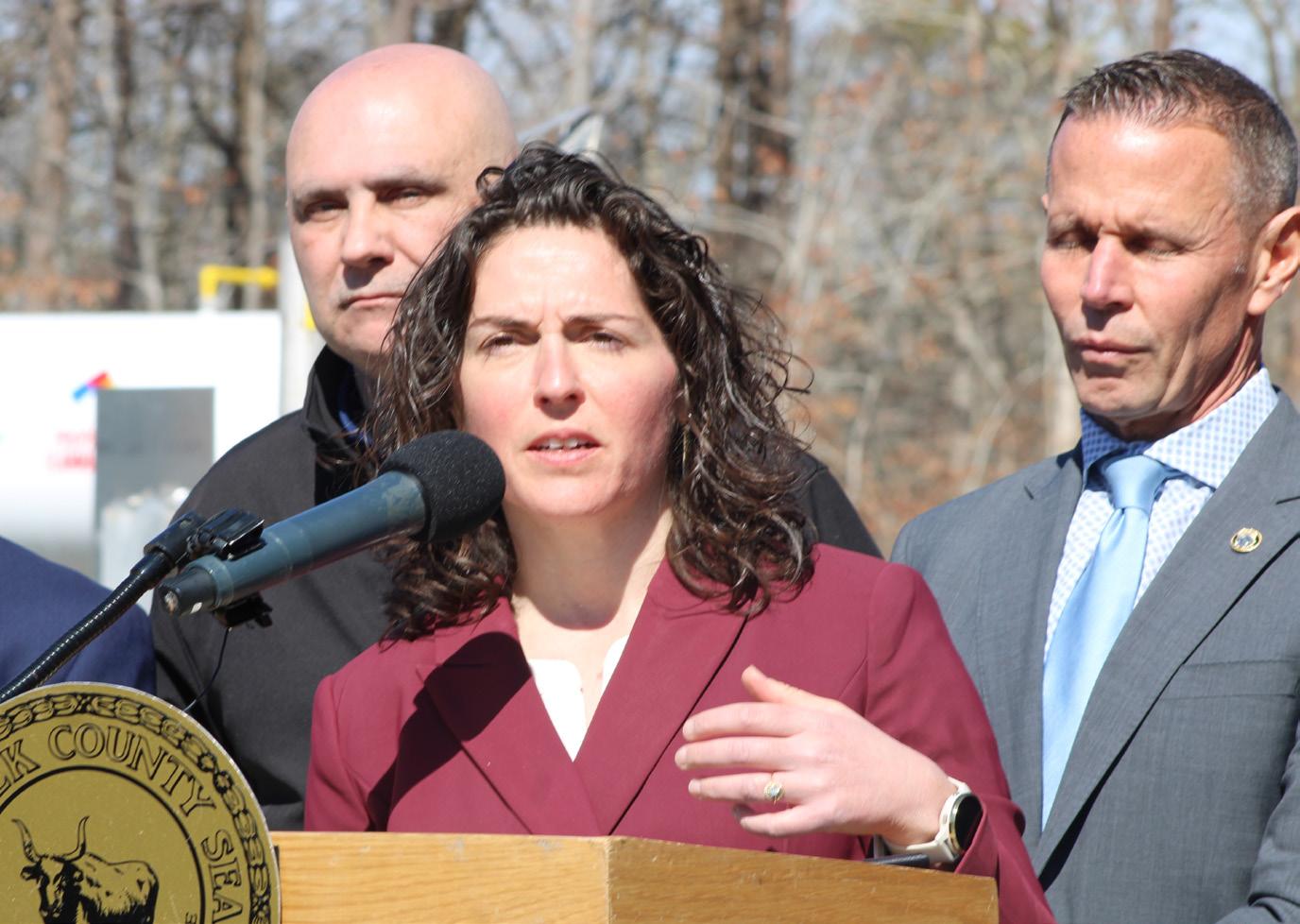

FRES Commissioner Sunderman and officials in Westhampton Beach on Saturday evening (Credit - Matt Meduri)

Fire Departments battle the blaze in Westhampton. (Credit - Office of Suffolk County Executive Ed Romaine)
So far, only one serious injury has been reported, a firefighter who received seconddegree burns to the face. He was airlifted to Stony Brook University Hospital for treatment on Saturday.
The Westhampton Beach Fire Department had two aviation units flying all day on Sunday, with the Suffolk County Sheriff’s Office sending fifty deputy sheriffs for protection.
Suffolk County Executive Ed Romaine (R-Center Moriches) announced that nearly ninety fire departments responded with apparatus, some as far west as Deer Park. Nassau County Executive Bruce Blakeman (R-Atlantic Beach) also dedicated resources from eleven agencies to eastern Suffolk.
“We had five brush trucks and five engines from Nassau. We also had twenty ambulances on site, but we’re also backfilling ambulances throughout the county to make
sure that we have coverage for the routine 911 calls,” Legislator Dominick Thorne (R-Patchogue), Chair of FRES Committee in the County Legislature, told The Messenger. “This is a standard pyramidtype response. When you drain resources, you bring more in and backfeed.”
Romaine also said he received “several” calls from Governor Kathy Hochul (D), who declared a state of emergency and an immediate burn ban for Downstate New York and parts of the Hudson Valley. The Governor also sent the State Department of Environmental Conservation (DEC), State Forest Rangers, State Park Police, and State Police. He also thanked the Suffolk County Water Authority (SCWA) - an public-benefit corporation independent from Suffolk County government - for their regular maintenance of hydrants and water mains that allowed these fires to be fought.
“Without the combined efforts of everyone involved, we would not have been able to stop this fire,” said Romaine.
“DEC was out there helping around the clock,” said Romaine on Monday afternoon, adding that he not only received a phone call from New York City Mayor Eric Adams (D) offering help, but also the White House.
Despite the circumstances, Romaine, who served on the Pine Barrens Commission for twelve years, called the outpouring of support and aid in a time of crisis as “humbling.”
“This is so humbling because you’re watching the fires destroy our Pine Barrens; you care about them and watch them burn. And when people are calling to say, ‘how can I help?’ It made all the difference,” said Romaine.
Brookhaven Town Supervisor Dan Panico (R-Center Moriches) told The Messenger on Saturday evening that neither road closures within the town, nor vehicular or dwelling damages had been reported.
“...had these winds blown to the southwest, this fire would have ravaged through potentially Eastport, the business district, Manorville, a ton of homes in East Moriches, it could have been a very different fire had it gone into Brookhaven Town,” said Supervisor Panico in a statement on Monday. Romaine and others were particularly concerned that if the fires jumped Sunrise Highway to head north, it could have been much more catastrophic, hearkening back to the Sunrise Fire of 1995, which burned for about one week and scorched 3,200 acres. The 1995 fire, believed to have been started by human activity, occurred under similarly dry conditions.
The Pine Barrens’ infestations from the Southern Pine Beetle are also considered to have been a catalyst in these flames, while not a cause themselves. The beetles are known for burrowing into pine trees - with a preference for Pitch Pine, a chief component of the Long Island Pine Barrens’ flora - creating S-shaped pathways while feeding on the tree’s cambium layer, the thin separator between the tree’s prominent nutrient highways. Popcorn-like nodules of resin are often left behind on the barks, a tell-tale sign of a pine beetle infestation.
Congressman Nick LaLota (R-Amityville), while thanking the first responders for their fantastic work in containing and extinguishing these fires, urged the U.S. Senate to pass the Fix Our Forests Act, a bipartisan bill passed March 6 to address the threat, among others, of the Southern Pine Beetle.
Once the trees cannot retrieve nutrients, they die, leaving behind dried bark and branches, which make for perfect kindling in wildfire conditions.
The pine beetles’ presence on Long Island is relatively new. While they’re endemic to the Southeastern U.S., warmer winters have brought them as far north as New Jersey and New York.
Thankfully, the Pitch Pine is known for its innate fire adaptation, offering a slight check on the power the beetles might have in setting the stage for a catastrophic blaze.
“I’m really pleased to report that [these fires] are 100% contained with a hard line. We’re remaining vigilant to ensure that we are continuing to do patrols, ensuring that we are addressing any hot spots as they come up,” said acting Commissioner for NYSDEC Amanda Lefton in Mastic on Monday, urging residents to comply with the burn bans.
While Long Island continues into a historic drought period, as does much of the U.S. at the time, take note of the burn bans in place for Long Island effective immediately. State bans take effect on March 16.
By Raheem Soto
If you were planning on burning some yard debris or enjoying a bonfire this weekend, think again.
Over the past week, brush fires have been breaking out across Long Island, with flames spreading quickly due to dry conditions and strong winds. In response, New York officials have issued a statewide burn ban to prevent future fires before they start.
It’s a precautionary move, and while it might put a damper on weekend bonfires and yard cleanups, it is meant to keep homes, businesses, and firefighters safe.
Most people think wildfires are a West Coast problem, affecting states like California and Oregon. However, in reality, New York is not immune. Dry conditions and strong winds can turn a tiny spark into a massive blaze.
Suffolk County saw multiple brush fires this past week, some tearing through the Pine Barrens, a wooded region known for its dry vegetation. Firefighters from more than eighty departments battled the flames, and while they managed to contain the fires, the risk remains high.
Governor Kathy Hochul (D) has declared a state of emergency and sent extra resources to help local fire crews. Officials are now taking the next step: stopping new fires before they even start.
What’s Not Allowed?
Under the burn ban, certain outdoor fires are temporarily prohibited:
1. Outdoor brush burning, including leaves, branches, or other yard waste
2. Uncontained campfires that are not in a fire ring or proper structure
3. Open cooking fires, unless specifically permitted

Not everything is off-limits. If you plan a backyard barbecue, you are still in the clear.
1. Gas grills, charcoal grills, and smokers are allowed
2. Contained campfires that are under three feet high and four feet wide in a fire ring, fireplace, or hibachi
3. Specific outdoor cooking devices, including maple sugar arches and similar structures
A Small Step to Prevent a Big Problem
Wildfires do more than destroy land—they put lives and homes at risk. And once they start, they are tough to stop.
Every year, states like California see devastating wildfires that cause billions in damages and force entire towns to evacuate. New York does not face fires on the same scale, but the risks are still real.
The Pine Barrens fire that started over the weekend
spread fast, fueled by dry brush and wind gusts. Evacuations were ordered, roads were shut down, and one firefighter suffered second-degree burns.
This burn ban is designed to prevent situations like this from happening again. Cutting out unnecessary fire risks now means fewer disasters later.
Officials are taking this ban seriously. If you get caught violating it, there could be real consequences.
1. Fines and penalties for those who ignore the restrictions
2. Legal action if a fire is started due to negligence
3. Increased risk of injury or loss of property if fires spread
Even with the burn ban, other ways exist to help reduce the risk of wildfires.
1. Never leave a barbecue or outdoor fire unattended, and always have water or a fire extinguisher nearby
2. Dispose of cigarettes properly, as a single spark can ignite dry grass
3. Follow local fire department guidelines and stay informed about any updates to the ban
4. Report smoke or suspicious fire activity immediately
This burn ban is temporary, and officials will continue monitoring conditions. The ban could be lifted if the weather shifts—such as a stretch of steady rain.
For now, the focus is on keeping New Yorkers safe. It is a simple step to reduce risks, protect firefighters, and prevent wildfires from getting out of control.
While it may not be ideal for those looking to burn debris or light an outdoor fire, the goal is to avoid unnecessary dangers.
Fires belong in fireplaces, grills, and fire rings—not in the woods.

This weekend displayed just how quickly a massive catastrophe can occur, but also how quickly it can be subdued.
However, some constituents aren’t as fortunate as we are to have competent and effective leadership, public safety, and fire/rescue personnel as we do in Suffolk.
County Executive Ed Romaine (R-Center Moriches) compared the successful combatance of the brush fires to the less-successful scenario that arose in Los Angeles at the beginning of the year. As much as officials, talking heads, and oped writers would like to attribute those devastating fires that created an apocalyptic wasteland in one of the nation’s former-most coveted “promised lands,” the catalysts were simply dereliction of duty.
California and some areas in the Pacific Northwest lagged behind in raking vital areas. Moreover, the homelessness has skyrocketed in places like Los Angeles, with reports of fire hydrant tampering demonstrating the hydrants’ lack of maintenance.
Governor Gavin Newsom (D-CA) contradicted himself on live television within a roughly thirty-second window. He first dismissed President Trump’s (R-FL) claims that the reservoir had been emptied and instead insisted that the reservoir was operational. When the reporter interviewing him brought up the facts, Newsom said, in an attempted “slick” manner, “and that’s why I’m calling for an investigation.”
Which is it? Was the reservoir full or there needs to be an investigation as to why it wasn’t?
Newsom’s clear egotism precedes his and company’s incompetence, with Mayor Karen Bass (D) unable to resist international trips, despite ample warnings of fire weather.
The Los Angeles Wildfires - more importantly, the scope and horror of the damage - are sickening to behold. This can’t be forgotten, and there needs to be perp
walks, or, at the very least, tarring, feathering, and running those responsible out of town on a rail.
We use this opportunity to draw a stark contrast. Our leaders were prepared, they were clearly trained excellently, they didn’t engage in double-speak, and they were able to bring a blaze that seemed of uncertain proportions down to full containment by Monday morning. Let the record show that the fires could have been just as bad, if not worse, than the 1995 Sunrise Fire had the flames jumped Sunrise Highway north into Manorville.
Our officials didn’t just respond to an emergency; they diverted us from a major disaster.
Moreover, SCPD Commissioner Kevin Catalina is committed to getting to the bottom of the cause of the fire. While the widely-accepted hypothesis is a backyard fire initiated by an attempt to cook s’mores, it’s possible more leads could arise.
Our question: who in the world cooks s’mores at 10:00 in the morning?
Negligence of the burn bans hereafter should result in criminal prosecution if another wildfire starts. The weather conditions might not spare us next time, even with the best of the best on the front lines. We will not become Los Angeles.
Sadly, when compared to the major failures of other administrations, it’s easy to lose sight of what actual leadership and initiative-taking looks like.
The Messenger sincerely thanks all fire, rescue, and emergency personnel, public safety, elected officials, and the fire departments from across Suffolk who pitched in for the effort, as well as elected officials from outside Suffolk who sent or offered help.
Neither the magnanimity of all parties involved, nor the possibility of what could have occurred, can be understated.
Suffolk County residents have a new reason to be skeptical about corporate accountability. After years of contamination, legal battles, and government red tape, chemical giants 3M, DuPont, and Chemours have finally agreed to massive settlements to help clean up toxic PFAS pollution. But while billions of dollars are now on the table, the real question remains—will that money actually make it into our communities and protect our drinking water?
For decades, these companies knowingly produced and sold products laced with per- and polyfluoroalkyl substances (PFAS), also known as “forever chemicals.” They were used in everything from firefighting foams to nonstick cookware, and they don’t break down naturally. Instead, they linger—in our water, our soil, and ultimately, our bodies. And now, they’re linked to serious health problems, including kidney and testicular cancer.
These settlements—$10.3 billion from 3M alone—sound like a win for communities that have been unknowingly drinking contaminated water for years. But here in Suffolk County, where PFAS contamination has already seeped into our water supply, local officials and residents are left wondering how much of this money will actually be used to fix the problem—and how long we’ll have to wait.
If you live in Westhampton Beach, Quogue, or Yaphank, you’ve likely already heard about the contamination issues. These aren’t isolated incidents—they’re part of a much larger crisis that has been building for years.
One of the worst offenders? Gabreski Air National Guard Base in Westhampton Beach, where firefighting foam containing PFAS was used for training. That foam soaked into the ground, contaminating the water supply and putting thousands of residents at risk. Brookhaven National Laboratory and various industrial sites across the county have also been flagged as potential contamination sources.
This isn’t just an environmental issue—it’s a public health emergency. PFAS have been linked to cancer, immune system damage, fertility problems, and even developmental delays in children.
The Suffolk County Water Authority (SCWA) has been aggressively testing and filtering PFAS from the local water supply, but the costs of doing so are staggering. The federal government only recently set stricter limits on PFAS in drinking water, but the truth is that communities like ours have already been dealing with the fallout for years.
With $10.3 billion from 3M, $1.19 billion from DuPont, and $750 million from Tyco Fire Products now up for grabs, you’d think that Suffolk County would be getting a huge payout to fix our water systems. But the reality is far murkier than the contaminated water itself.
For starters, these funds are being distributed over the next thirteen years. That means the money won’t be hitting local governments’ accounts overnight. And even when it does, it comes with a bureaucratic nightmare of applications, approvals, and oversight that could slow things down for years.
Then there’s the biggest concern: will Suffolk County actually get enough money to make a real impact?
Over 11,000 public water systems across the country are affected by PFAS
contamination, all competing for a piece of these settlements. Even if Suffolk secures a decent chunk of the funds, will it be enough to cover the skyrocketing costs of filtration and remediation?
The SCWA, a public-benefit corporation independent from County government, which serves over 1.2 million residents, is already investing in advanced filtration systems to remove PFAS from drinking water.
But upgrades like these don’t come cheap. Some estimates suggest that full remediation efforts could cost far more than what these settlements will provide.
And then there’s the question of who, exactly, will oversee these funds. Will local communities have a say in how the money is spent? Or will it be tied up in state-level politics, with Albany deciding how much actually makes it back to Long Island?
If history has taught us anything, it’s that big settlements don’t always mean big results for the people who need them most.
Just look at the opioid crisis settlements—billions of dollars meant to help communities ravaged by addiction. Yet, much of it has been mismanaged or spent on things unrelated to actual recovery efforts.
Or take the September 11th Victim Compensation Fund. After years of bureaucratic holdups, first responders had to fight tooth and nail to get the promised benefits.
So, forgive Suffolk County residents for not jumping for joy just yet. We’ve seen this movie before.
This money needs to go directly into cleaning up our water—no delays, no excuses. That means upgrading and expanding PFAS filtration systems in our water treatment plants immediately, not waiting for studies or more bureaucracy. We must hold polluters accountable beyond just this settlement. If new cases of PFAS contamination emerge, Suffolk must take swift legal action to secure additional funds.
Ensure local governments—not just Albany—have control over how this money is spent. The people who drink this water should have a say in how it’s cleaned. Keep residents informed. Too often, these public health crises are swept under the rug once the headlines fade. Suffolk residents deserve regular updates on where the money is going and how it’s being used.
While these settlements are a step in the right direction, the fight isn’t over. Suffolk County’s leaders need to stay aggressive in securing the funds we need to fix our water—and we, as residents, need to hold them accountable to ensure they do.
Because if there’s one thing we’ve learned, it’s this: corporations might be paying for the damage they caused—but it’s up to us to make sure that money makes a difference.
For now, stay informed, stay vocal, and keep demanding better. Because when it comes to our water, “good enough” just isn’t good enough.
Is your home affected by PFAS contamination? Check with the Suffolk County Water Authority (www.scwa.com) for local testing and filtration options.
By Congressman Nick LaLota
The extraordinary dedication of Long Island’s First Responders was on full display during the recent brush fires that tore through parts of Brookhaven and Southampton Towns. Their swift and selfless response not only protected lives and property but earned national attention — and deservedly so. Even leaders at the highest levels of government have recognized their bravery.
This past Sunday, I was in Westhampton Beach meeting with First Responders and State, County, and Town officials. I saw firsthand the relentless work of more than ninety fire departments from across Long Island — men and women who fought through the night and into the next day to contain the blaze. Once again, these heroes put their lives on the line for our communities, and we owe them our deepest gratitude and unwavering support.
But gratitude alone is not enough. Their heroic response demands equally strong action from all levels of government. While initial estimates suggest that total uninsured public damage may fall short of the $37.5 million threshold needed for federal disaster aid, that shouldn’t stop Washington from acting. We need to strengthen prevention policies now to stop future fires before they start.
In Congress, I recently helped pass the bipartisan Fix Our Forests Act, which includes my provision to combat Long Island’s devastating Southern Pine Beetle infestation — a key driver of the dead, dry vegetation that makes these fires worse. My provision requires targeted federal action to reduce these fire risks, but this can’t be the end of the fight. The Senate should pass this important legislation without
By Carole Trottere
further delay.
Albany can’t sit idly by either. I’m calling on Governor Hochul to provide more resources for controlled burns and back policies — like those in the Fix Our Forests Act — to speed up the removal of dangerous wildfire fuel. The time for mere talking is over. Suffolk County’s communities, forests, and drinking water need action now.
These fires are a wake-up call. The Pine Barrens Preserve, which sits atop a federally recognized drinking water source, has been ravaged by the Southern Pine Beetle for years. Governor Hochul has acknowledged this growing threat — now she must follow through. With large sections of untouched but parched forest still at risk, we can’t afford to wait for another fire to strike.

I’ll continue working in Congress to deliver resources and solutions, but this must be a team effort — free of politics — to protect Long Island’s environment and safety. Our First Responders deserve nothing less.
Congressman Nick LaLota (R-Suffolk County) is a lifelong Long Islander in his second term representing Suffolk County in the U.S. House of Representatives.
At this point, there can’t be a person left on Long Island who hasn’t heard about the opioid/fentanyl crisis—an epidemic that has claimed the lives of thousands of Long Islanders since it began more than twenty years ago and over a million Americans nationwide. One of those statistics is my son.
Alex was 30 years old when he died on April 8, 2018.
To date, fatalities from the fentanyl crisis surpass the combined death toll of both World Wars and the Vietnam War.
So, when I hear that the Centers for Disease Control (CDC) reports a nearly 24% national decline in U.S. drug overdose deaths—from 114,000 lives lost the previous year to 87,000 between October 2023 and September 2024—I don’t think, “Great news!”
Instead, I think about the parents, grandparents, siblings, and friends of those 87,000 souls who will never come home again.
The Weight of Collective Grief
The fentanyl epidemic has left Long Island—and the nation—dotted with the walking wounded. These are the people left behind: the ones grieving a loss almost too heavy to bear.
A recent poll shows that 1 in 4 Americans knows someone who has died from an opioid or fentanyl-related death. Chances are, you do too—a neighbor’s child, a former classmate, a coworker, a friend.
There is a collective grief spreading across this country, a grief that demands recognition, compassion, and action.
A Generation Under Siege
My heart breaks for young people, many of them my son’s contemporaries, who have lost dozens of friends to this crisis. How do you process such relentless loss?
For those who have struggled with addiction themselves, or are still using, grief is even more complicated. The stigma around drug use often silences them, making it harder to seek support. Not since the HIV/AIDS epidemic of the 1980s has a generation been so devastatingly hit by death among their peers.
And then, there are the grieving parents.
The Stigma of Grief
We know what people whisper about us. We feel the judgment. We see the assumptions—“They must have been bad parents.”
When I assist the Suffolk County Police with Narcan training, I often hear parents say: “I don’t need that. My kids are good kids.”
Ouch.

That stigma—the one that tells people, “this can’t happen to me”—has fueled two decades of government inaction. It has kept some school districts from providing life-saving education, afraid of the label: “a school where kids do drugs.”
The Reality
Here’s the truth: Many fentanyl poisoning victims had no history of drug use. They were young people who made one impulsive mistake—taking what they thought was a prescription pill at a party, buying something from a dealer on Snapchat. A counterfeit pill laced with fentanyl ended their lives in an instant. No second chances. No do-overs.
A Call to Action
It’s time to move beyond stigma.
It’s time to acknowledge our collective grief and demand real action—services that support families, education that saves lives, and policies that address the crisis head-on.
If you are a grieving parent who has lost a loved one to fentanyl, you are not alone. Organizations like the Long Island Council on Alcoholism and Drug Dependence (LICADD) and GRASP offer grief support groups where you can find solidarity and healing.
And if you know someone who has suffered a loss, be kind.
Offer compassion.
Offer a hug.
They are carrying more than you can imagine.
By Frank Montanez
2024 was a great year for The Chamber of Commerce of the Mastics and Shirley, but 2025 looks even better! We were proud to hold our annual events like Casino Night, gave two scholarships to William Floyd students, and had our Annual Christmas Parade. We also added more things to benefit our members like a Grant to help one local business and held our first Food Truck Rally and Car Show.
This year we are expanding to offer two small business grants, recognizing a student of the month, and free outdoor concerts and movies in partnership with the library. We are so excited to bring back our traditional events as well.
Thanks to the Downtown Revitalization grant and the Town Of Brookhaven, we are going to be installing new decorative lamp posts along Montauk Highway. This will be a multi-phase project, but we are thrilled to be able to get it started.
Our membership has been expanding greatly, and we are so happy to welcome new members each year. We can accredit this to getting back to our roots of bridging
commerce and community. We have been able to do this by offering free events to the community and helping our small businesses. We have also ben holding a free Business Expo and Career Fair that helps the community to learn what jobs and careers are right her in our own back yard,
With many new Board members and a fresh new outlook, we are so excited to be working together to help our small businesses. Helping them connect and network monthly has proven to help them expand and work closely with each other. While we are proud of the things already accomplished, we are so excited to see how much further we grow!

Frank Montanez, of FMJ Productions, is the current president of the Chamber of Commerce of the Mastics and Shirley.
Thursday, March 13, 2025
By Matt Meduri
Long Island MacArthur Airport (ISP) has regularly offered four carriers: Frontier, Southwest, JetBlue, and Breeze, with Breeze beginning service at the airport in 2022, followed by JetBlue in 2024.
Now, ISP boasts another carrier: Avelo.
Like Breeze, Avelo is a new carrier, having been founded in 2021. Established as Casino Express Airlines in 1987, the carrier serviced western destinations exclusively to Elko, Nevada. Casino Express expanded and changed its name to Xtra Airways in 2005 to reflect a much broader customer base.
Xtra was acquired in 2018 by Andrew Levy, former president of Allegiant Air and CFO of United Airlines. Levy’s intent was to charter the airline as an ultra-low cost carrier, similar to Breeze Airways’ mission statement. In 2021, the airline was announced under its current name, Avelo, and was based out of Hollywood Burbank Airport in California, one of five commercial airports in the Los Angeles Metro Area. Its inaugural flight took place in April from Burbank to Sonoma


Just a month thereafter, Avelo announced a new base at Tweed New Haven Airport in Connecticut. Initially slated for four routes between New Haven and Florida, the carrier had expanded its service to twenty-six destinations by 2024, making New Haven the largest base for Avelo. The airline posted its first profit in the fourth quarter of 2023.
Since 2022, Avelo has established three more base airports: Orlando (MCO), Wilmington, Delaware (ILG), and Raleigh-Durham International (RDU). It’s Las Vegas (LAS) base was relocated to Charles M. Schulz-Sonoma County Airport (STS) in May 2024.
Now, Islip MacArthur Airport is offering exclusive and direct service to three destinations, all of which are satellite airports to much larger international airports in major cities. Starting May 22, travelers can fly from ISP to Concord-Padgett Regional Airport (USA), home to Concord, North Carolina, a suburb of Charlotte. Service will be seasonal. Additionally, starting June 12, travelers will be able to fly from ISP directly to Lakeland Linder International Airport (LAL) - Lakeland being a smaller city west of Orlando, Florida - and Wilmington International Airport (ILM) to the well-known, beachfront destination of Wilmington, North Carolina. Service will be regular for both routes.
All flights will be operational on Tuesdays and Thursdays until demand can be further gauged to determine a schedule more tailored to travel patterns.
Islip Town Supervisor Angie Carpenter (R-West Islip) (pictured above) was joined by Town Councilman John Lorenzo (C-West Sayville) (pictured right) - whose district contains the airport itself - as well as ISP Airport Commissioner Shelley LaRose-Arken and Deputy Commissioner of Aviation Rob Schneider were there to say “hello to Avelo.”

Councilmen Jim O’Connor (R-Great River), Jorge Guadrón (D-Central Islip), and Mike McElwee (R-West Islip) were also in attendance, as well as Islip Town Clerk Linda Vavricka (R-West Islip) and Islip Town Receiver of Taxes Andy Wittman (R-Sayville).
“Avelo recognizes the advantage of smaller airports for a hassle-free and convenient travel experience. Avelo understands the benefits of smaller airports, fewer crowds, shorter lines that travelers enjoy a smoother, stress-free journey from check-in to boarding,” said Supervisor Carpenter, adding credit to the various teams employed at ISP, notably referring to the TSA crew there as “friendlier than any place in the country.”
The Islip Town and ISP officials were also joined by Jim Olson, head of Brand and Communications for Avelo Airlines, to formally introduce the carrier to Long Island.
“Our purpose at Avelo is to inspire travel. We do that by making it easier and more affordable so people can travel more. And we do that by doing three things. Our value proposition includes convenience, affordability, and reliability,” said Olson, expanding on their three tenets.
Of the convenience aspect, Olson said Avelo “loves airports like Islip.”
“This is our kind of hometown, friendly, and welcoming airport,” said Olson. Avelo’s marketing caters to the smaller, regional airports across the country, with Islip being no exception. The three destinations announced connect Islip to similar airports without being too remote from the action of urban centers, tourist attractions, and core downtowns. ConcordPadgett Regional Airport (USA) offers service to Charlotte, without having to navigate a much larger airport in Charlotte Douglas International (CLT). The regional airport in Concord allows travelers to access Charlotte without the hassles of long wait times, large or, at times, confusing terminal layouts, and various shuttle buses and trains to connect to other terminals, baggage claim carousels, and rental car services.

“Flying into Charlotte is no longer going to be a hassle,” said Councilman Olson (pictured left). He explained this logic in Avelo’s first airport of service, Burbank, which was proposed as an alternative to the iconic, yet often notorious, Los Angeles International (LAX) Olson said the same of Orlando, which he calls “convenient” until the aspects of navigating the terminal and services come
into play.
The second tenet of Avelo’s mission is affordability.
“We have everyday low prices,” said Olson, announcing that if trips are booked by Monday, March 17, for any of the three new destinations announced, travelers can take advantage of introductory rates: $59 one-way fares to Wilmington and Concord, $69 one-way fares for Lakeland.
“This conversation wouldn’t be complete if I didn’t share how proud we are as an airline of our extraordinary reliability,” said Olson, referencing the third cornerstone of Avelo’s value proposition. “From the start, Avelo has been one of America’s most reliable airlines. In 2024, we actually ranked number one in on-time performance and delivered the lowest flight cancellation rate in the country. As a three-yearold airline, we’re pretty proud of that.”
“We know that we have to earn your business, that we have to earn your trust, but we hope you’ll give us a shot,” closed Olson in his pitch to the public.
“I warmly welcome the new carrier. Together with my fellow board members and the Supervisor, we are committed to expanding this economic pillar of our region and this district in Islip,” said Councilman Lorenzo.
“There’s a ton of energy in our community in wanting our airport to grow, and our Town Board and our Supervisor have been huge advocates of that,” said Commissioner LaRose-Arken (pictured right), adding that constituent suggestions for routes are frequently submitted to the Town Board to be presented to ISP. The Town and the airport continue to encourage community input for future routes.

On their website, Avelo advertises customer service perks unique to most other carriers, particularly in the forms of free family seating and no internet booking or convenience fees. The airline shares these features with American Airlines, Alaska Airlines, and JetBlue, while Spirit, Sun Country, and Allegiant offer neither. Breeze, Delta, Southwest, and United offer one of the two.
ISP travelers can still access Orlando (MCO) directly by flying Southwest, JetBlue, or Frontier.


Home for Funerals & Cremations ~
r y J Maher Lic Manager & Director
In Honoring eir Legacy ~ Deacon Kenneth J. Maher, Aelysche Marie Maher & Kenneth J. Maher, Jr. Serving All Surrounding Communities Proud to Serve Our Veterans, Law Enforcement and Fire Service Our State-of-the
By Matt Meduri
President Donald Trump’s (R-FL) Cabinet is almost at full power, with just the position of Ambassador to the United Nations remaining unfilled. Congresswoman Elise Stefanik (R, NY-21) was one of Trump’s first Cabinet nominees in the wake of his election, but Congressional Republicans appear to be slow-walking her confirmation votes until House vacancies are filled. Republicans are highly likely to retain the seats of FL-01 and FL-06 in the April 1 special elections, restoring their quorum to 220.
Dorothy Shea is serving as the acting U.N. Ambassador.
Stefanik notwithstanding, all of Trump’s nominees for Cabinet and Cabinet-level positions have been confirmed, with two nominees having been confirmed within the last week.
Former Congresswoman Lori Chavez-DeRemer (R-OR) (pictured right) has been confirmed as Trump’s Labor Secretary. She represented OR-05 for just one term in the House before being defeated for re-election in 2024.
Chavez-DeRemer has only been seen as a somewhat controversial nominee because of her support of the Protecting the Right to Organize (PRO) Act, which would expand workers’ rights to collectively bargain and would weaken right-towork laws, which are on the books in twenty-seven states. Fervent libertarian Senator Rand Paul (R-KY) was the only Republican to oppose the advancement of her nomination from committee.
Chavez-DeRemer was confirmed on March 10 in a 67-32 vote with just one abstention. She received the support of sixteen Democrats, with Senators Chuck Schumer (DNY) and Kirsten Gillibrand (D-NY) voting in opposition. Senator Paul was the only Republican to not back Chavez-DeRemer in the final vote.
De facto Department of Government Efficiency (DOGE) Administrator Elon Musk has said that the department does not “exist” anymore.
Trump and company believe that the department has been taken over by “radicals, zealots, and Marxists,” while also arguing that the federal government wastes taxpayer money by effectively meddling in state and local education decisions.
In February, the department created an “end-DEI” portal to field complaints about such programs in schools, and just this month, the Education Office of Civil Rights announced that sixty universities are under investigation for anti-semitism.
On March 11, the Trump Administration fired more than 1,000 workers in the Education Department.
While Trump and his team are looking to drastically downsize the department and effectively neuter it from within, only Congress can create or abolish Cabinet or Cabinet-level departments.

However, one of Trump’s most contentious nominees, Linda McMahon (R-CT) for Secretary of Education, was confirmed last week on March 3. She cleared her Health, Education, Labor, and Pensions (HELP) Committee hearing in a party-line 12-11 vote in February.
The final Senate vote resulted in a 51-45 confirmation last week, also a party-line vote, with two Republicans and two Democrats not voting.
McMahon previously led the Small Business Administration in Trump’s first term. She, along with her husband, Vince McMahon - both long-time friends of Trump - founded Titan Sports, which later became World Wrestling Entertainment, Inc. (WWE). McMahon also ran two failed bids for the U.S. Senate in Connecticut in 2010 and 2012.
McMahon’s confirmation now begins one of the most controversial, yet, to some, a most welcomed, campaign promise: dismantling the Department of Education.
Founded in 1979 by President Jimmy Carter (D-GA), the department has four key functions: establishing policies on federal financial aid and monitoring those funds; collecting data on U.S. schools; focusing national attention on key issues within schools and making recommendations for education reform; and prohibiting discrimination.
The department has 4,000 employees, the smallest staff of any Cabinet agency, and its 2024 budget consisted of $268 billion, up $14 billion from when it was founded in 1979.
The day McMahon was confirmed, she emailed department staffers about the Education Department’s “final mission,” to “send education back to the states.”
Trump also aroused no suspicions about his intentions for the department, saying on the day of McMahon’s confirmation vote that he wants her to “put herself out of a job.”
In election news, Democrats received their third consecutive blow to their electoral prospects in 2026.
Senator Jeanne Shaheen (D-NH) announced on March 12 that she will not seek a fourth term next year. The move comes off the heels of retirements from Senators Gary Peters (D-MI) and Tina Smith (D-MN). While the Michigan race was already seen as highly competitive - Republicans haven’t won a Senate race there since 1994 - Peters’ retirement creates an open-seat environment where virtually anything is possible. Democrats will likely have to fight harder than they have in decades to retain that seat.
While Minnesota and New Hampshire are competitive at varying levels, both have been obdurately blue for long periods of time. Shaheen defeated oneterm Senator John Sununu (R-NH) to flip the seat blue in 2008. She became the first Democrat to win this particular New Hampshire Senate seat since 1972. Shaheen’s membership of the Senate contributed to a historic moment for one of the most Republican states in the country when Maggie Hassan (D-NH), then the governor, ousted then-Senator Kelly Ayotte (R-NH) in 2016. The flip allowed Democrats to control the Granite State’s entire congressional delegation for the first time since 1854.
While Republicans can certainly compete here, Republicans have had problems with the national environment and candidate quality in New Hampshire, especially in the Trump Era. In 2016, it was the closest state not carried by Trump, but Kamala Harris (D-CA) won it by about three points in 2024 - a close race, but not as close as it was eight years prior.
Shaheen’s retirement is also a blow to Democrats’ chances at retaking control of the chamber as the only two Republican-held seats, as of now, considered competitive are North Carolina - a pure toss-up - and Maine - Senator Susan Collins (R) is an institution here. Democrats might experience a further net loss in 2026, and retirements that create open seats cannot be afforded in such a fight.
as Governor of New Hampshire from 1997 to 2003.
Governor Kathy Hochul (D) (pictured below) has signed an executive order barring corrections employees who took part in the strikes from being hired for state jobs.
Hochul also recommends that striking offers be removed from the Central Registry of Police and Peace Officers, which would disallow them from being hired as police or peace officers in state and local capacities.
“There are consequences when people break the law, and that means you’re not working in our state workforce, ever,” said Hochul on Tuesday.
The New York Department of Corrections and Community Services (DOCCS) had been striking for over twenty days over deplorable and unsafe working conditions in State prisons, as well as overworked staff and failure to provide inmates with medical care and other services. The strike was officially over on Monday, although the DOCCS has not met the threshold of 85% striking workers to return to their jobs that day. Daniel Martuscello III, Commissioner of NYDOCCS, said that more than 2,000 striking workers were terminated on Monday after they failed to return to work by the deadline.
Seven incarcerated people have died during the strike, with investigations probing as many as nine correctional officers who could be implicated in the latest death, that of Messiah Nantwi at Mid-State Correctional Facility in Marcy (Oneida County).
The strike has been considered unlawful since its inception, as New York State Civil Service Law Section 210, known as the Taylor Law, prohibits strikes by public employees for the purpose of safeguarding vital public services.
The Suffolk County Legislature is seeking applicants for its 2025 Page Program.
Applications are open to undergraduate- and graduate-level interns who are interested in gaining real-world experience in government and public service. Students can connect with legislators, elected officials from other levels of government, County department heads, and staff all throughout Suffolk County. Pages not only gain insight and advice on policy, leadership, and public relations, but can also receive school credit for the internship, pursuant to individual school guidelines.
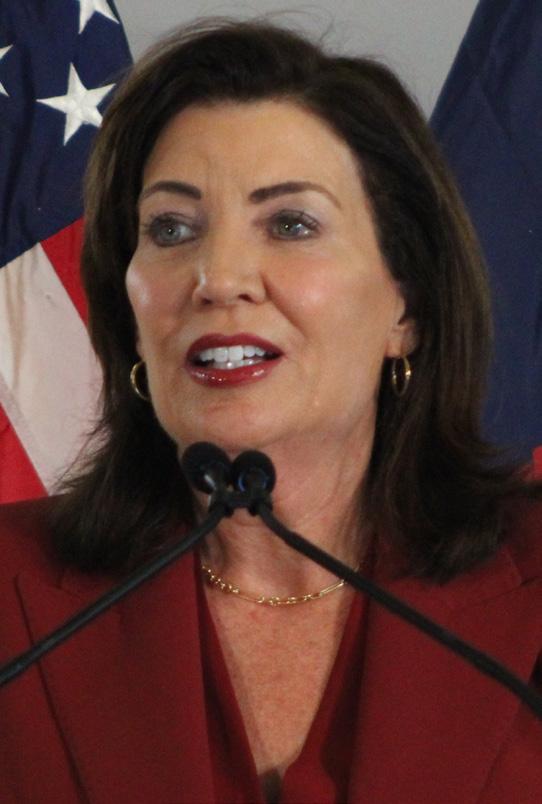
Moreover, if former Governor Chris Sununu (R-NH), a wildly popular Republican in his home state, should throw his hat in the ring in 2026, it would be considered the worst-case scenario for Democrats in a state where Republicans have not nominated the strongest candidates in recent cycles.
Notably, Shaheen is the first woman in U.S. history to serve as both a governor and a U.S. Senator. She served
Interns will also have the opportunity to participate in a mock legislative session, in which students take the roles of legislators, form caucuses, and debate policy. Bi-weekly workshops will be held by various elected officials as well.
“As an elected official, I am always inspired by our legislative interns. They bring a refreshing perspective to the discussions of how government works and how it can improve,” said Presiding Officer Kevin McCaffrey (R-Lindenhurst).
“Each year, we have seen an impressive lineup of students from not only the SUNY system but from prestigious universities across the nation. Some interns come from schools of law and from various graduate-level studies, and some hope to make those a goal. Many express a desire to enter public service following their education. This program provides an invaluable start.”
Students who wish to enroll may sign up on the Suffolk County Legislature’s website at link - https://www.scnylegislature.us/ DocumentCenter/View/120781/2025Page-Application-PDF - or by scanning this QR Code: For more information or to submit a report, call the DEC at 844-332-3267.
Continued from front cover
The Tri-Hamlet area has seen a number of renovations in recent years, including, but not limited to, the reconstructions of the three branches of the Mastics-Moriches-Shirley Library, the initial studies and public meetings for the Neighborhood Road Revitalization Area (NRAA), and a possible move of the Yaphank LIRR Station to better serve residents in the Shirley Industrial Park.
Ten residential properties were already hooked up last week, with the facility ready to treat wastewater from nearly 2,000 homes and businesses. The opening of the plant also offers relief to many residents, who have received flood mitigation funds from FEMA after devastating flooding from Superstorm Sandy in 2012. Such coastal flooding has also prompted the actions of wastewater treatment in the area, as cesspools and septic systems have caused great harm to the aquaculture in the Great South Bay when flood waters recede carrying wastewater with them.
“This is a unique project,” said Suffolk County Executive Ed Romaine (R-Center Moriches), expanding on the three “basic expenses” of sewers: the sewer line itself, the meters before homes and businesses that are connected, and the connection from the meter at the street to the structure. “This was unique because we intended for everyone to hook up and, because we were using federal funds, we were able to pay for the residents’ meters and the hookups to the houses, which [individually] is a couple thousand dollars. All of this turned out to be about $228 million. If anyone thinks that sewers are not expensive, they are.”
However, Romaine and officials stress that the Forge River is “one of the most impacted” rivers, for a variety of reasons, including typical cesspool waste, but also the former duck farm industry that had a presence in the area. The Jurgielewicz Duck Farm was the largest at the height of the industry, but closed in 2011. The farm claimed to be the largest free-range duck operation in the country, raising one million Pekin ducks per year.

of Moriches Bay, acted as a boon to the duck ranching industry. However, the ranches have been attributed to pollution problems with unusually high amounts of duck-derived phosphorus in the waters near the farming sites.
“Please use some of the Environmental Bond [Act] money - $4.1 billion - to help with sewers and water mains for those still on private wells,” said Romaine, asking Governor Kathy Hochul (D) to spearhead State funds for Long Island’s environmental problems. “70% of the county is on septic systems or cesspools,” Romaine added. “We’re hoping to use some of that Environmental Bond money to put people to work, create jobs, and build an infrastructure that will make sure we have a clean and prosperous future.”
Romaine also offered a deal to the State: “We’ll match dollar-for-dollar all your Environmental Bond money that is put into sewers and clean water.”
Newly-minted New York State Department of Environmental Conservation (DEC) Commissioner Amanda Lefton, a Long Island native, echoed Romaine’s comments on water quality.
“I know just how important water is to our communities; it’s in so many ways our lifeblood,” said Lefton. “Protecting our water is such an important part of our life here on Long Island. We [DEC] intimately understand that.”
Lefton added that while economic growth can be spurred by wastewater plants, the bigger mission is reducing nitrogen that enters waterways and bays that degrade water quality and coastlines.
“Here on Long Island, it’s not just big extreme weather events that are causing flooding in our communities, but even day-to-day,” said Lefton. “We’ve been partnering with the County on replacing aging septic systems and cesspools to provide grants to homeowners to help repair existing cesspools, and we’re going to leverage nearly $1.2 billion in funding committed to date from the historic 4.2 billion dollars Clean Water, Clean Air, and Green Jobs Environmental Bond Act.”
Lefton says such funds can help communities becmore “more resilient to climate change, improve water quality, conserve critical open spaces, protect wildlife, and help to ease the transition to a clean-energy economy.”
Lefton also said that a large component of these initiatives is partnership.
“We’re all in this together and we can’t do it alone,” said Lefton, adding that Governor Hochul and the State are “committed” to investing in environmental issues on Long Island.
Suffolk County Legislator Jim Mazzarella (R-Moriches), who represents the Tri-Hamlet Area, called the opening of the plant a “great day for the Forge River and its surrounding waterways,” calling the plant “state-of-the-art.”
“This facility is going to treat wastewater from nearly 2,000 homes and about 250 businesses,”
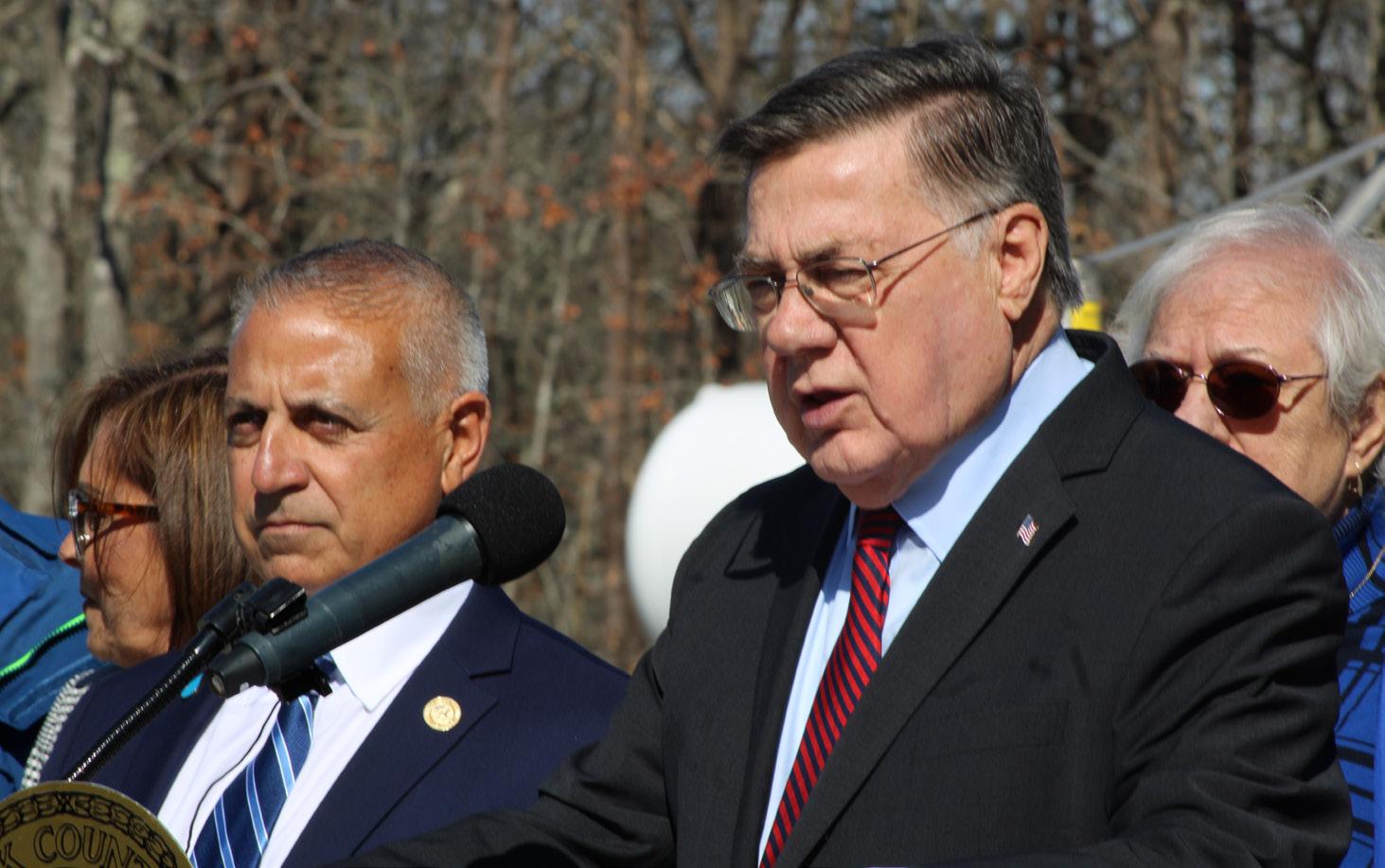
said Mazzarella, adding that the businesses of the main corridor in the Mastic Beach area and along Montauk Highway will benefit economically from the plant.
“Most important, I have to mention the residents themselves who chose this by a vote to bring in this district and create it so that we can stand here today and celebrate this great momentous occasion with this beautiful plant that we have here,” said Mazzarella.
Mazzarella also mentioned community advocates present at Monday’s press conference, such as John Sicignano, President of the Mastic Park Civic Association, and Frank Fugarino, of the Pattersquash Creek Civic Association.
“If it was not for the efforts of these civic leaders as well as some past civic leaders we would not be here today,” said Mazzarella.
“This is the first plant we have completed in decades,” said Suffolk County Department of Public Works (DPW) Commissioner Charlie Bartha, with Executive Romaine interjecting, “But not the last!”
“This is a one million gallon-per day plant now. We’re already in the design stage to increase it by 450,000 gallons per day. The good news is that it’s a tertiary treatment plant,” said Bartha. Tertiary treatment involves treating wastewater and removing contaminants to allow the water to be reused or discharged back into the aquifer through leaching pools. There are 519 leaching pools, all below ground, just east of the plant along the North Service Road of Sunrise Highway.
“It has zero impact on the community,” said Bartha of the pools. “It’s a tribute to all the people in the community. You need patience to make something like this go forward, and we’ve had patience from the community. We’ve had hard work from people in the Department of Public Works as well as our engineers and contractors. We pledge to be good neighbors.”
“We pledged a long time ago to make sure that we’re going to do what we can to not only help the Forge River area, but other areas around the county,” said Presiding Officer Kevin McCaffrey (R-Lindenhurst), whose leadership in the Legislature has been a critical aspect of Romaine’s objectives in sewering vulnerable parts of Suffolk County. “As the county executive said, we stand on the water that we drink. We need to do all we can. We’ve done our part in the county. We’re asking the State and the federal government to assist us to continue to do this. This is just the beginning here of what we’re going to do on Long Island to make clean water even cleaner.”
Deputy County Executive Jennifer Juengst, the de facto “water czar” for Suffolk, has been fighting for clean water on Long Island as an attorney for twenty-five years.
“This is a temple basically to how the future of Suffolk County should look,” said Juengst. “The people of Mastic and the Shirley area around the Forge River must be incredibly proud today.”
“We plan to spend at least $1 billion in extending sewers over the next three years,” said Romaine, referencing ongoing projects and studies in South Huntington, Kings Park, and Oakdale. “The first priority is the areas that are the most densely populated and are still on septic systems and cesspools. I’m hoping that the state will be our partner in some of this, and they’ll give us money not only for sewers, but for clean water for those people still on well water that are drinking well water that is currently impacted.”

By Raheem Soto
Millions of Americans rely on Levothyroxine Sodium every single day to treat hypothyroidism. It’s one of the most commonly prescribed medications in the country, and yet, thanks to a bureaucratic mess, access to this essential drug is at risk.
But now, a bipartisan group of lawmakers is stepping up to fix the problem before it spirals out of control.
Congressman Andrew Garbarino (R-Bayport), along with Representatives Tom Suozzi (D-Glen Cove), and Diana Harshbarger (R, TN-01) have reintroduced the Ensuring Access to Essential Drugs Act, a straightforward bill aimed at protecting access to vital medications while ensuring small American manufacturers aren’t crushed under unnecessary regulations.
“This legislation puts patients first by ensuring the affordability and accessibility of widely used medications,” said Garbarino. “It also reinforces our support for small businesses and American manufacturing, ensuring that U.S. companies remain competitive and resilient in the global market and ensuring that small, familyowned companies like Long Island’s Jerome Stevens Pharmaceuticals can continue their vital work.”

That’s why Chirag Patel and Chintu Patel, co-CEOs of Amneal Pharmaceuticals, another major industry player, are backing this bill.
“At Amneal Pharmaceuticals, we believe that no patient should ever have to worry about access to the lifesaving medicines they depend on,” they said in a joint statement. “This bipartisan legislation is a vital technical fix that will safeguard access for the 19 million American patients who rely on levothyroxine. It will also help ensure a reliable, high-quality domestic supply for what is one of the most commonly prescribed chronic disease therapies for Americans. Regulatory technicalities should never stand in the way of patient care. For many, this medication is not just important—it’s a lifeline. I urge Congress to prioritize patients over bureaucracy and pass this common-sense solution to protect those who need it most.”
It’s rare when politicians from both sides of the aisle, small business owners, and even prominent industry leaders agree on something.
At the heart of the issue is Medicare’s Part D Manufacturer Discount Program—a well-intentioned policy that, like so many government regulations, ended up creating unintended consequences. The program, designed to reduce drug prices, ended up placing an unfair financial burden on companies like Jerome Stevens Pharmaceuticals (JSP), a family-run business based in Bohemia, New York.
Without relief, JSP and others like it could be forced to scale back production or shut down entirely, leaving patients scrambling to find alternative sources for a drug they depend on.
“This bipartisan legislation provides a common-sense fix to help a Long Island business provide 19 million American patients with an essential drug they need,” said Suozzi. “Hyper-technical language will hurt this company and these patients, and they need a fair exception under Medicare. Let’s get it done.”
Levothyroxine Sodium is the only FDA-approved treatment for hypothyroidism, a condition that affects millions of Americans, particularly women and older adults. Without it, people can suffer from fatigue, weight gain, depression, and even lifethreatening complications.
“As a lifelong pharmacist, I am dedicated to ensuring that Americans always have affordable access to the life-saving medications that they need,” said Harshbarger. “This bill addresses a critical oversight in the Inflation Reduction Act to help ensure that levothyroxine sodium—one of the most widely prescribed drugs in the United States—can continue to be produced domestically and remains accessible to the patients who depend on it.”
This bill ensures that Levothyroxine Sodium and similar medications won’t get caught in regulatory red tape. It amends Title XVIII of the Social Security Act to exempt certain orally administered drugs from the Medicare Part D Manufacturer Discount Program. The exemption applies to drugs approved under an NDA (New Drug Application) in accordance with the FDA’s 1997 Federal Register Notice and granted a “narrow exception” under the Medicaid Drug Rebate Program (MDRP).
Translation? It’s a targeted, precise fix that prevents government bureaucracy from disrupting the supply of essential medications.
Jerome Stevens Pharmaceuticals isn’t just a random drug company—it’s a homegrown American success story. For nearly fifty years, this family-run business has been producing high-quality medications in the U.S. at a time when many pharmaceutical companies have moved production overseas.
This bill isn’t just about patients—it’s about keeping American manufacturing alive.
“Jerome Stevens applauds the introduction of legislation that will ensure that the 12 million Americans affected by hypothyroidism continue to have access to domestically manufactured Levothyroxine Sodium Tablets at an affordable price,” said Daniel Akeson, Director of Jerome Stevens Pharmaceuticals.
What’s happening here is a classic example of government rules designed for big corporations crushing smaller, family-run businesses.
Under current Medicare rules, major pharmaceutical companies can absorb the financial hit of the Part D Manufacturer Discount Program. But the financial burden is overwhelming for smaller companies like Jerome Stevens Pharmaceuticals. Some large companies are happy to see small competitors squeezed out. Less competition means more market control and, eventually, higher patient prices.
This shouldn’t be a partisan issue. It’s about fixing an obvious flaw in the system before it harms millions of people.
If Congress doesn’t act, millions of Americans could see their access to Levothyroxine Sodium disrupted, prices rise, and another small American manufacturer be driven out of business—all because of bureaucratic red tape.
The Ensuring Access to Essential Drugs Act is now in front of Congress. The question is—will lawmakers do the right thing, or will they let needless red tape dictate the health and well-being of millions of Americans?
One thing’s for sure: patients, small businesses, and everyday Americans are watching.

A group of thirty-eight Ward Melville High School students recently returned from an unforgettable nine-day expedition to Ecuador and the Galápagos Islands. This immersive educational adventure, which took place during the February break, provided firsthand experiences of one of the world’s most unique ecosystems and vibrant cultures.
The journey began in Quito, Ecuador’s capital, where students marveled at the opportunity to stand on the equatorial line. From there, they ventured to the Galápagos Islands, a UNESCO World Heritage site renowned for its pristine natural beauty and extraordinary biodiversity. Exploring the islands, the high schoolers encountered iconic wildlife such as giant tortoises, marine iguanas, blue-footed boobies and playful sea lions. Snorkeling in crystal-clear waters, they swam alongside sea turtles, penguins and an array of colorful reef fish.
Beyond observing wildlife, students gained a deep appreciation for the delicate ecosystem of the Galápagos and the vital role conservation plays in protecting its unique biodiversity. They explored diverse landscapes, from the lush highlands with towering Scalesia trees to the resilient mangroves and cacti that thrive along the coast.
The adventure concluded in Otavalo, an Andean town known for its rich cultural heritage. There, students immersed themselves in the local way of life, exploring bustling marketplaces, visiting artisans and engaging with musicians who preserve indigenous traditions. By experiencing their lifestyle, they developed a newfound appreciation for different cultures and the resilience of communities thriving with limited resources.
This extraordinary journey provided students with invaluable lessons in environmental science and global awareness. As they returned home, they carried with them lasting memories and a deeper understanding of the world beyond the classroom.


At the recent Board of Education meeting, the Sachem Central School District announced key leadership appointments. Patrick Burke has been named principal of Sachem High School North and Ralph Carusillo Jr. has been appointed director of alternative learning.
Burke, who previously served as assistant principal at Sachem North, has played a vital role in developing the master schedule, organizing
major school events and enhancing community engagement. He has also worked to implement restorative practices throughout the district. Burke holds an advanced graduate certificate in educational leadership from Stony Brook University and a master’s degree in special education from Dowling College.
Carusillo, currently assistant principal at both Sachem High School North and Sagamore Middle School, brings extensive experience in curriculum development and student support services. He has led initiatives such as the Seal of Civic Readiness program and coordinated intervention services for students in need. Carusillo holds certifications in school building leadership and school district leadership, along with an educational leadership certificate from Stony Brook University.
The district congratulates Burke and Carusillo Jr. on their new roles and looks forward to their continued contributions to Sachem’s educational community.
Blue Point Elementary School Principal Tara Falasco found herself in a sticky situation in February. Students had covered her in duct tape and wondered if she would stick. She did.
The prank was part of an Election Day lesson in which students held their own “vote” to decide what fun prank they would play on their principal. Among the options were having

her kiss a farm animal or spraying her with silly string. In the end, the students chose the ultimate prank—covering her in duct tape.
They were “glued” to this activity as they watched to see if she would really stick to the wall and ended up enjoying learning the benefits of voting as well as gravity.


Published
Dozens of Rocky Point High School student-actors took to the stage to perform “Hello Dolly,” the beloved story of widowed, socialite-turned-matchmaker Dolly Levi and a talented cast of characters that she assists in finding love.
The show featured senior Maya Alexander in the leading role as well as seniors Derek Bergmann, Darren Castellucci, Angelina DeRosa, Sebastian Garske, Isabella Kelly, Brianna LoPiccolo, Maya McCarthy, Skyler Ogonowski, Samantha Palmese, Katie Romano, and Markuz Tiburcio in standout performances.
The talents on stage were accompanied by Rocky Point student-musicians and stage crew, set construction and front of house in a performance that captured the hearts of the audiences in the weekend performances.


Centereach High School is excited to announce that two of its standout students, Ahmed Malik and Cemal Tastan, have earned first place in the prestigious Financial Services Team Decision-Making event at a recent DECA competition. This impressive accomplishment has secured them a spot to represent Centereach High School at the New York State Career Conference in Rochester this March.
The New York State Career Conference will bring together over 3,000 talented students from across the state, where Ahmed and Cemal will have the opportunity to showcase their knowledge and decision-making skills in front of industry professionals. The event will feature role-playing scenarios where students engage with business leaders, demonstrating their ability to solve real-world challenges in a competitive setting.
DECA is a globally recognized organization that provides high school and college students with the opportunity to prepare for careers in marketing, finance, hospitality, and management. It plays an essential role in fostering emerging leaders and entrepreneurs, equipping them with the tools they need for future success in the business world.
“We are incredibly proud of Ahmed and Cemal’s hard work and dedication,” said Thomas Bell. Centereach High School principal. “Their achievement showcases their talents and highlights the strong foundation of leadership and business skills fostered at Centereach High School. We wish them the best of luck as they continue their journey at the New York State Career Conference!”
This recognition reflects the commitment of Centereach High School’s DECA program to preparing students for success in a variety of fields, and we look forward to seeing Amad and Cemal compete at the next level.
For more information regarding the Middle Country Central School District and its students’ many achievements, please visit the District’s website: https://www.mccsd.net/.
Eastport-South Manor Jr.-Sr. High School math teacher Theresa DiMarco was one of twenty-one educators on Long Island recognized with the Association of Suffolk Supervisors for Educational Technology Bright Light Awards. The award recognizes teachers who have made significant contributions in integrating technology into the classroom.
District Director K-12 Mathematics
Justin Grover explained that Ms. DiMarco has been instrumental in introducing
the Formative program, which is an essential tool for the junior-senior high school in collecting curriculum and instruction data. Furthermore, Ms. DiMarco has been willing and dedicated to supporting colleagues with learning the Formative program, resulting in their reliance on Formative as a primary tool in the Data Wise data collection process for continuous improvement.
The district congratulates Ms. DiMarco on this outstanding accomplishment.
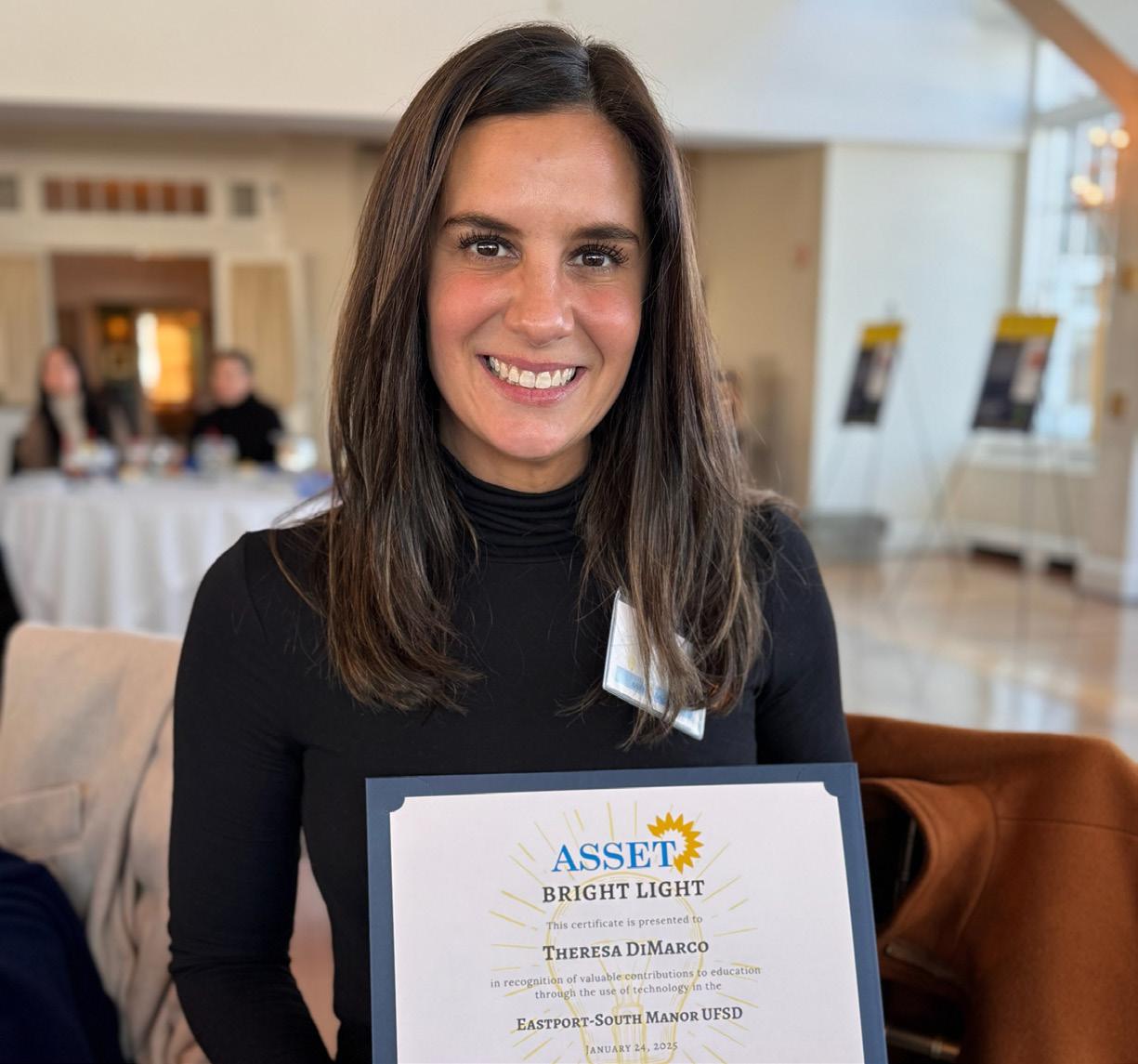
By Matt Meduri
The federal government, primarily the Office of Management and Budget (OMB), defines and delineates the United States’ areas for statistical purposes. We’ll discuss the different rankings, what characteristics constitute each ranking, and where the different regions of the country stack up in terms of overall population.
Core-Based Statistical Areas (CBSAs)
Core-Based Statistical Areas contain a large population core - or innermost urban area complemented by urban infrastructure and economic footprint - and adjacent communities that are highly integrated with said core. Counties containing these population subsets are defined as having at least 50% of their population living in urban areas of at least 10,000 people. Surrounding counties, otherwise referred to as outlying counties, can be included in a CBSA if these counties have strong enough social and economic ties to the urban cores, primarily through employment and commuting rates. Outlying counties are only included if 25% of the workers living in the core area(s), or vice versa.
This column will seek to address the long-forgotten concept of civics and how it relates to American government in general, from the federal level to the local level. This column will explore Constitutional rights, the inner workings of government, the electoral process, and the obligations and privileges of citizens.

bottom-five on this list.
Of the μSAs losing population, four of the bottomfive are located in the Deep South: Clarksdale (Mississippi), Selma (Alabama), Gallup (New Mexico), Vicksburg (MS), and Pine Bluff (Arkansas).
CBSAs can be merged into a single CBSA when the central county or counties of one jurisdiction qualifies as a relevant county or outlying county to other CBSAs. One or more CBSAs can be grouped together to form a Combined Statistical Area (CSA) when the employment interchange measures reaches 15% or more. Essentially, when two statistical areas reach a point of considerable interdependency, the areas can be merged for statistical purposes.
Note that any designation of a statistical area is not a political or governmental boundary, rather just another way for the federal government to categorize residence, employment, and traveling behaviors and patterns.
CBSAs are then further subdivided into Metropolitan Statistical Areas (MSAs) and Micropolitan Statistical Areas (μSAs)
Metropolitan Statistical Areas (MSAs)
Created in 1910 by the Census Bureau, Metropolitan Statistical Areas - often colloquially referred to as “metro areas” - was a standard classification for a large urban area and their surrounding areas, with the original qualification being 200,000 people. It was later towered to 100,000 in the 1930s, and again to 50,000 in 1940. The OMB submitted a regulation for public comment that would increase the minimum population needed for an MSA to be 100,000, but the 50,000-population threshold remained in place for the 2020 Census.
MSAs are geographical regions with relatively high population densities and a large economic presence in their respective regions. There are 387 MSAs in the United States. All fifty states plus the District of Columbia have MSAs within their borders.
As of the 2020 Census, the largest MSA is of no surprise: New York-Newark-Jersey City, NY-NJ MSA. With a population just over 20 million - now closer to 19 million as of 2023 estimates - the OMB estimates a near 3% decrease in population. The New York Metro Area is often referred to as the Tri-State Area, sometimes as “Greater New York.” It is the largest metropolitan economy in the world with a gross metropolitan product of over $2.6 trillion USD. The area includes all of Long Island, New York City, reaching its New York terminus in Ulster and Dutchess counties. It includes the three westernmost Connecticut counties, most of New Jersey, and one county (Pike) in Pennsylvania.
Following New York is Los Angeles-Long BeachAnaheim, Chicago-Naperville-Elgin, Dallas-Fort WorthArlington, and Houston-Pasadena-The Woodlands rounding out the top five. Atlanta-Sandy Springs-Roswell
makes for number six, followed by Washington-ArlingtonAlexandria, Philadelphia-Camden-Wilmington, Miami-Fort Lauderdale-West Palm Beach, and Phoenix-Mesa-Chandler.
The least populous MSAs include Lewiston, Idaho; Enid, Oklahoma; Walla Walla, Washington; Carson City, Nevada; and Eagle Pass, Texas.
In terms of net change since the last census, WildwoodThe Villages, Florida, clocks in at number one, experiencing a 17% increase. Myrtle Beach-Conway-North Myrtle Beach, Lakeland-Winter Haven (Florida), St. George (Utah), and Wilmington (North Carolina) make up the top-five.
The top-three losers in terms of population are all located in Louisiana, with San Francisco-Oakland-Fremont taking number four at a net 4% loss.
Micropolitan Statistical Areas - also called “micro areas,” but less used than “metro areas” for the former - are often centered on an urban cluster, but contain more than 10,000 people and less than 50,000. The μSA designation was created fairly recently in 2003, although the term gained traction in the 1990s to descibe growing population centers that are removed from much larger cities, often more than one hundred miles away.
μSAs’ classifications can vary more starkly compared to those of MSAs. Since these designations rely on a core urban area’s population, and not on that of an entire geographic area, some μSAs are much larger than others.
For example, consider the Ottawa, Illinois, μSA. As of the 2010 Census, this μSA had a population exceeding 150,000 people, putting its population ahead of nearly one hundred other comparable areas. The μSA spans across three counties just outside of the Greater Chicagoland area.
Consider also the Claremont and Lebanon, New Hampshire, μSA. Since the cities are their respective counties’ only cities, and due to their proximity to other urban cores, the population of the μSA exceeded 200,000 in 2010, despite both cities only having slightly more than 13,000 people each.
The OMB recognizes 542 μSAs in the country, four of which are in Puerto Rico.
The top μSA by population is Seaford, Delaware, at 263,509 residents, which also has one of the largest net increases in population at 11%. Seaford is followed by Lebanon-Claremont (NH-VT), Hilo-Kailua, East Stroudsburg (Pennsylvania), and Concord (New Hampshire). Jefferson (Georgia), Cedar City (Utah), Sandpoint (Idaho), and Granbury (Texas) have seen the largest changes in population, with Jefferson, Georgia, being within the Atlanta-Athens-Clarke County-Sandy Springs CSA.
The least-populous μSA is Vermillion, South Dakota, at just north of 15,000 residents. Atchison (Kansas), Snyder (Texas), Spencer (Iowa), and Baker City (Oregon) take the
CSAs were first designated in 2003, defined as combinations of adjacent MSAs and μSAs with economic ties solidified by commuting patterns. What distinguishes a CSA from an MSA or an μSA are social and economic ties within, primarily that ties between MSAs and μSAs individually within a CSA are at lower levels than between the counties within an MSA. In other words, a CSA will likely see larger ties between its various designated areas than the counties themselves would see. It fleshes out a true relationship between urban areas and the traffic within a designated economic area than simply looking at county-by-county data and inter-county relationships.
OMB identifies 181 CSAs in the country, with the New York-Newark CSA being the most populous at just under 22 million residents as of 2023 estimates. For the scale of the list, the least-populous CSA is Spencer-Spirit Lake, Iowa, at just 34,000 estimated residents.
CSAs can be a combination of MSAs and μSAs, MSAs and MSAs, or just μSAs and μSAs. The Albany-Schenectady CSA includes two MSAs (Albany-Schenectady-Troy and Glens Falls) and three μSAs (Hudson, Gloversville, and Amsterdam).
While there is no formal ranking below the μSA, at least in the eyes of the OMB, the Census Bureau recognizes other municipalities as CDPs. The classification has been used in each decennial census since 1980, primarily as the counterpart to incorporated places, self-governing areas that have a level of home rule apart from the parent constituency, such as a township or county.
Suffolk County’s villages are a prime example of incorporated areas. Villages require a simple majority of the area’s residents to vote in favor of incorporating, in which official boundaries of the village are set, a mayor and trustees (or village board) are elected, and departments are assigned services that are no longer provided by the county or town. Well-known villages across Suffolk include Greenport, Southampton, Patchogue, Bellport, Port Jefferson, Babylon, and Northport. Lesser known, at least relatively speaking, villages include Old Field, Poquott, Brightwaters, Dering Harbor, Sagaponack, North Haven, Askaroken, and even two on Fire Island, Ocean Beach and Saltaire.
The CDPs in Suffolk, lovingly referred to as hamlets, are not incorporated, and thus rely on the county and their respective towns for their services. There is no official organized government at the hamlet level, nor are there official boundaries. However, the CDP does recognize longagreed-upon boundaries for statistical purposes.
CDPs outside of Suffolk can not only include a smaller, unincorporated community, but also large tracts of land that is sparsely populated or entirely uninhabited, as well as other small nearby communities.
CDPs have no legal status and occasionally clash with regional understandings of the area. A perfect example is that of Nesconset and Lake Ronkonkoma, with the southern third of the former having long been recognized by residents as Nesconset. However, inspecting a CDP map shows that, in the Census’ eyes, the hamlet of Nesconset does not include any territory south of Old Nicolls Road, meaning that the southern third is technically considered the hamlet of Lake Ronkonkoma for statistical purposes.
Suffolk County Legislator Jim Mazzarella (R-Moriches) joined Caitlyn Michiels, founder of the nonprofit Caitlyn’s Vision, alongside colleagues in government, friends, and family, to witness the H. Lee Dennison Building illuminated in green in honor of Rare Disease Day in Suffolk County.
Caitlyn Michiels, a dedicated advocate for children with visual impairments, approached Legislator Mazzarella earlier this year with the idea of officially recognizing the last day of February as Rare Disease Day in Suffolk County—aligning with efforts in municipalities across the country. Thanks to her advocacy, Legislator Mazzarella introduced legislation that not only designates this important day but also directs the Suffolk County Department of Public Works to illuminate the county’s executive offices in green—raising awareness for rare diseases.
A Global Movement for Rare Diseases
Rare Disease Day is an internationally recognized initiative dedicated to advancing equity in healthcare, diagnosis, and treatment for individuals living with rare diseases. Since its inception in 2008, the movement has united a global community, amplifying awareness and advocating for improved care. Observed annually on February 28 (or February 29 in leap years—the rarest day of all), the day is symbolized by the zebra, representing the uniqueness of rare diseases.
The green illumination of the H. Lee Dennison Building was chosen specifically to honor Caitlyn’s Vision, whose signature color is green.
Caitlyn’s
Caitlyn Michiels’ advocacy began at the age of eight after being diagnosed with Anterior Bilateral Uveitis, a rare eye disease and the third-leading cause of childhood blindness. Determined to make a difference, she founded Caitlyn’s Vision, launching fundraising campaigns, collecting used eyeglasses, and championing initiatives for children’s eye health.
Her impact has been significant:
• 2019 – Successfully advocated for August to be designated as Children’s Eye Health and Safety Awareness Month in Suffolk County.
Supervisor Daniel J. Panico (R-Center Moriches) has announced that the 2025 Brookhaven Town Youth Bureau’s INTERFACE Coat Drive collected 1,567 coats and hundreds of pairs of winter gloves, hats and scarves. The items, generously donated by residents, will be distributed to several churches, shelters, youth agencies, families, and veterans in need. The Town of Brookhaven’s 2025 Coat Drive ran from January 7 through February 7. Pictured is Town of Brookhaven INTERFACE Coordinator Josephine Lunde checking in donated winter clothing.
The Youth Bureau INTERFACE Program is a partnership between individuals, good corporate neighbors, and the Town of Brookhaven united in a common effort to provide help to Brookhaven’s less fortunate residents. It provides goods and services to those in need and addresses social issues.
For more information about the INTERFACE Program and Brookhaven Youth Bureau, please call 631-451-8011 or visit www.brookhavenny.gov.

• 2020 – Donated specialized light covers to the William Floyd School District to aid visually impaired students.
• 2024 – Advocated for inclusive playgrounds in Suffolk County, ensuring the addition of bright colors and textured edges to assist children with visual impairments and disabilities.
Now, at just 14 years old, Caitlyn has added another achievement to her growing list—successfully advocating for the official recognition of Rare Disease Day in Suffolk County.
“I was once someone with a rare disease who didn’t have support. I never want anyone to feel the way I did,” said Caitlyn Michiels. “Lighting the building shows these patients that Suffolk County cares for and supports them. In order to bring awareness to research, we need to keep the conversations going. I am thankful for my partner, Legislator Mazzarella, and all the legislators for their support.”
“Caitlyn is a true inspiration to young people everywhere,” said Legislator Mazzarella. “She has never let her diagnosis define her. Instead, she has turned her challenges into a mission to help others live better lives. Caitlyn is someone our entire community can be proud of.”
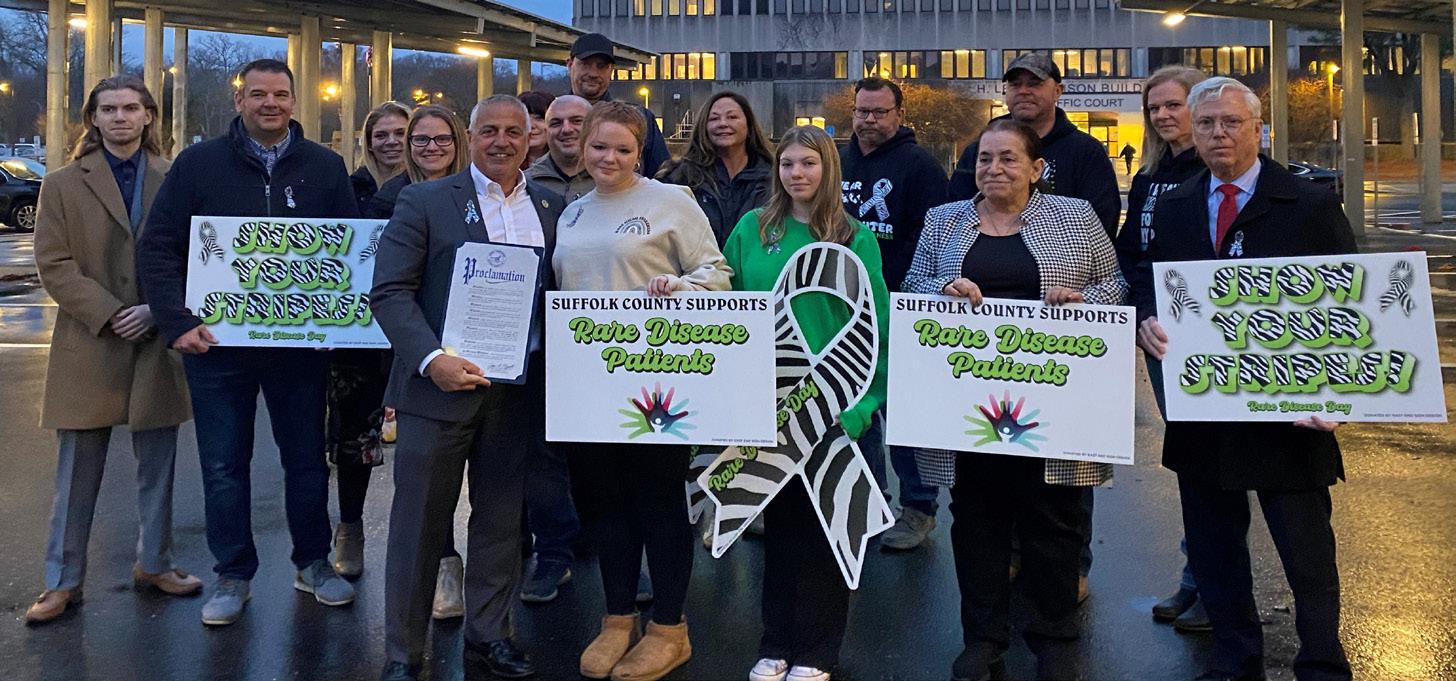
Thursday, March 27th 1:00pm-7:00pm

Participating donors will receive a coupon for a pint of your choice of Italian Ice (Farmingville location)
All donors will receive hero, salad, and refreshments!
Scan QR Code to make an appointment Any Questions call Jennifer 516-310-2382 Medical Questions please call 1-800-688-0900


Published by Messenger Papers, Inc.
Thursday, March 13, 2025
By Ellyn Okvist, B.Sc.
Lillian Brown Devere (1875 - March 29, 1955) was a Charter Member and President of the Lake Ronkonkoma Equal Rights Suffrage Club 1912. However, her story intertwines with much more information.
The entire Devere Family, including father, uncle, aunt, grandmother, and grandfather were in the theater. Learning about Lake Ronkonkoma from a wardrobe mistress, beginning in 1875 they would come out from Manhattan and rent a home during the summer season. Lillian visited the Lake from Manhattan for the summers beginning in 1875. She married Gustavus Devere on November 26, 1899, and came here permanently in 1899 and lived with her in-laws on Lake Shore Drive in an opulent home they built in 1884. It boasted a fireplace in every room and overlooked the lake. It was located approximately 400 feet west of Horseshoe Cottage. The family sold the house in 1907 and Gustavus and Lillian built a lovely period “cottage” on Hawkins Avenue. They moved in during April 1907 but had to take a room at Palmers Hotel at the railroad Station for the first night planned. There was a snowstorm, and Mr. Overton, owning the carriages, would not drive the horses through the storm.
Gustavus’s family was well known in theater, and Lillian was a teacher in her early career. As a community-minded woman, she started the Lake Ronkonkoma Dramatic Club in 1899. Her friends, including Maude Adams, the Broadway actress; Captain George McCormick (Civil war); Madame Cornelie Meysenheim, the world-class Opera Singer, and local residents all worked with Lillian in the Lake Ronkonkoma Dramatic Club. The group produced plays and recitals, held at Hook & Ladder #1, whose stage she had personally designed when it was built in 1904. The proceeds helped the Hook & Ladder #1; the Lake Ronkonkoma School; her passion, the Lake Ronkonkoma Free Library, and other local establishments.



During WWI, she served as a Yeoman in the United States Navy and was instrumental in 1921 for organizing the drive to establish the WWI Memorial Rock. As the main organizer of the memorial, the rock she chose had Revolutionary War significance for the British as they occupied Long Island. The WWI Memorial Rock was Landmarked on November 11, 1923. Lillian was also the “push” to organizing the Veterans to start the American Legion in 1926.
Post-WWI, the country once again resumed the fight for suffrage, and Lillian found herself in two major causes: the library and suffrage.
The Lake Ronkonkoma Free Library had its roots in the Women’s Suffrage Movement. In 1914, she acquired eighteen books on loan from the Equal Franchise Society. She kept the books in the pantry closet of her dining room. The key was always on the top ledge of the door molding.
This beginning led to her timeless additions to our town.
Many suffragists/ettes visited and spent weekends at the Devere home. As the interest in the library grew, the time came for a larger and more complete library to be built as a small addition off the side of her kitchen in her established home. There was a separate outside door and a pad and pen for the borrowers to leave the information as the “check out.” The interior was tongue and groove oak, with multiple shelves on all four sides, excluding the interior door. Just prior to the demolition of the home, our group was able to remove, label, and pack the entire interior, piece by piece, and have them stored for future reconstruction in another place. We also have many of
the books that were in the library, all with distinctive pencil numbers on the first page, which were given to us by the Newton family.

The time had come to expand the library, and Lillian was told by the New York State Education Division that, being a woman, she could not initiate the request herself; she would need five men to validate the application.
So be it.
After her hard work, the dream came true for the Lake Ronkonkoma Free Library. The Lake Ronkonkoma Free Library opened in 1916. Most of the early librarians were members of our Suffrage Club. Lillian Devere remained vice chairperson of the library until her death.
The Provisional Charter of the University of the State of New York was issued on May 25, 1916; the Absolute Charter of the Lake Ronkonkoma Free Library was issued by the University of the State of New York on March 27, 1919.
Preparing for the move to the new building, March 24, 1961, the Sachem Public Library was issued a Provisional Charter. On April 28, 1961, the Approval of Transfer of Library Property from Lake Ronkonkoma Free Library to Sachem Public Library was issued. On April 28, 1961, Cancellation of Charter issued March 25, 1916, was issued. The Absolute Charter of the State of New York Educational Department issued on September 22, 1966, granted the library to now be called Sachem Public Library.
It has been a long, successful period for the Sachem community. The Sachem Public Library has kept up with the promise made to our community in 1916. To remind us, the library had its roots in the Women’s Suffrage Movement. Visit the Lillian Devere Room at the Library next time you stop in. Lillian took a keen interest in civic affairs and was a firm advocate of Votes for Women and an untiring worker for the well-known suffragist Rosalie Gardiner Jones who was her frequent guest when organizing the Lake Ronkonkoma Equal Rights Suffrage Club. Lillian had the full support of her husband, and they marched together in New York City and Brooklyn suffrage parades. In town, she marched and attended rallies and events, bringing support to their cause with great style. They were active in Riverhead, Huntington, East Hampton, and, of course, Lake Ronkonkoma, to name a few. The club sponsored dances, held Euchres (a card game), held booths at athletic events, and on Memorial Day, Fourth of July, and Labor Day. The eighteen books on loan from the Equal Franchise Society have captured 109 years of service to the community.
If Lillian would read this today, she would state she did not deserve any honors for her accomplishments. Her quote was, “This is what a community must do”.
Lillian had four children: George, Mary, Lillian, and Helen. The two girls, Helen and Mary, lived at the family home on Hawkins Avenue until their deaths. Lillian passed peacefully on March 29, 1955, and is interred at the Lake Ronkonkoma Cemetery.
Lake Ronkonkoma had many huge influences for suffrage, another being May Duffield who was highlighted in my column last week, and two more columns over the next two weeks that will continue my highlights. My thoughts are, when do we see such powerful women in one community, all adding to what we enjoy today? I ask that if anyone has further information on other suffragist women in Lake Ronkonkoma, please contact me.

Published by Messenger Papers, Inc.
Thursday, March 13, 2025
By Mollie Barnett
In San Francisco’s technology hub, a venture once dedicated to democratizing artificial intelligence now stands accused of restricting access to its most powerful capabilities. OpenAI, the catalyst of the current AI revolution, faces growing scrutiny over its strategic direction—a trajectory with potential implications for America’s competitive position in global AI development.
When Elon Musk co-founded OpenAI in 2015 with Sam Altman and others, the organization articulated a clear mandate: develop artificial general intelligence for humanity’s benefit, unconstrained by commercial pressures that might compromise safety or accessibility.
By 2025, OpenAI’s evolution appears complete. The organization now commands a $157 billion valuation, bolstered by Microsoft’s $13 billion investment. More significantly, OpenAI is reportedly developing specialized vertical AI systems for legal, medical, and professional sports applications—with unconfirmed reports suggesting pricing may reach $20,000 per month per seat.
Industry analysts note the apparent contradiction: an entity named “Open” AI operating among the most closely guarded systems in the technology sector, with a pricing structure potentially limiting access to well-capitalized enterprises.
The philosophical distance between Musk and Altman has expanded considerably. In December 2024, Musk stated unequivocally on X: “OpenAI is now extremely closed source and maximizing profit, the exact opposite of the original mission.” His February 2025 acquisition offer of $97.4 billion for OpenAI, as reported by the Wall Street Journal and Associated Press, was promptly rejected by the board—underscoring his determination to redirect what he perceives as mission drift.
Altman’s perspective reflects a different assessment: developing advanced AI systems requires substantial resources achievable primarily through profitoriented structures. OpenAI’s December 2024 reorganization of its commercial division as a public benefit corporation attempts to reconcile these competing imperatives, though critics characterize this as superficial realignment rather than substantive recommitment to founding principles.
OpenAI’s rumored “PhD-MBA level” vertical solutions appear designed for sectors with significant financial resources and complex regulatory environments. While the company has not officially confirmed the reported $20,000 monthly per-seat pricing, such figures align with discussions circulating among Silicon Valley executives.
A March 5 post on X expressed concern about OpenAI potentially charging between $2,000 and $20,000 monthly for premium AI access, suggesting such pricing would restrict capabilities to “the rich and elite.”
At the upper end of this spectrum, annual licensing would approach $240,000 per seat—surpassing twice the median American household income. The strategic implications are significant: rather than democratizing specialized expertise, such AI implementation potentially reinforces existing economic stratification, insulating high-compensation professions while constraining broader innovation potential.
A critical question permeates industry discourse: Does OpenAI’s technical performance justify premium pricing? While the company historically maintained clear technical leadership, the limited transparency surrounding recent model capabilities raises legitimate questions.
Microsoft CEO Satya Nadella’s 2024 assertions regarding GPT-4’s competitive advantages lack independent verification through objective benchmarks. Concurrently, technology commentators have questioned whether OpenAI’s $200 monthly subscription offerings deliver the advanced capabilities marketed.
This transparency deficit creates problematic information asymmetry in the marketplace. Potential enterprise customers must largely accept OpenAI’s internal performance claims without comprehensive third-party validation— contrasting sharply with open-source alternatives that invite rigorous external scrutiny.
The DeepSeek Alternative
As American technology leaders debate AI accessibility models, China advances methodically. DeepSeek, established in 2023 by former ByteDance AI researchers, has achieved a significant technical milestone: developing competitive opensource AI systems at substantially lower cost structures than industry incumbents.
DeepSeek’s R1 model, released January 2025, reportedly matches OpenAI’s reasoning capabilities while operating at 20-50 times lower cost, according to the company’s statements. More significantly, DeepSeek provides unrestricted access to developers and researchers globally.
Venture capitalist Marc Andreessen has publicly acknowledged DeepSeek’s approach as beneficial to global innovation, noting its departure from the revenue-maximization strategies adopted by leading American AI developers.
DeepSeek’s operational efficiency merits particular attention. Despite U.S. restrictions limiting access to cuttingedge semiconductor technology, the company reportedly invested less than $6 million in model training using Nvidia H800 processors—demonstrating that innovation can sometimes transcend
capital constraints.
Private Development Alternatives
Between OpenAI’s proprietary ecosystem and DeepSeek’s open-source framework exists a third pathway: custom language models configured for specific operational requirements. Industry specialists estimate that developing organization-specific AI systems typically requires $50,000 to $100,000 in initial investment—substantial but significantly below OpenAI’s rumored monthly subscription rates.
Organizations increasingly explore internal AI infrastructure development rather than committing to recurring licensing expenses. This trend reflects not merely cost considerations but growing organizational requirements for control, customization, and data sovereignty in AI implementations.
These private models, optimized for specialized knowledge domains, present an alternative vision where artificial intelligence enhances human expertise rather than centralizing or restricting it.
The debate extends beyond business models to a fundamental conceptual question: Should artificial intelligence function as infrastructure or commodity?
Musk’s position appears unambiguous: AI should operate as essential infrastructure comparable to electrical grids or internet connectivity— foundational technology accessible across economic sectors. This framework positions intelligence as a public resource driving innovation throughout the economy.
Conversely, Altman’s OpenAI has increasingly adopted a commodity model where capability access correlates directly with pricing tiers. This approach extends traditional software licensing structures to a fundamentally different technological capability—systems that can reason, create, and solve complex problems.
Technology policy analysts caution that America’s market orientation may obscure a critical paradigm shift in how artificial intelligence should be conceptualized and distributed. When intelligence itself becomes a premium commodity, unprecedented barriers to innovation potentially emerge.
The infrastructure perspective gains credibility through historical comparisons. The internet’s transformative economic impact stemmed primarily from its open protocols and widespread availability rather than restricted access models. Similarly, nations that treated electrification as infrastructure rather than luxury service experienced accelerated industrial development and broader economic advancement.
As OpenAI’s organizational trajectory continues, the implications transcend
corporate strategy to affect America’s position in global AI development and broader economic competitiveness.
National security and technology policy experts argue that widespread AI adoption fundamentally determines national competitive advantage. China’s multifaceted approach—supporting both government-sponsored AI initiatives and enterprises like DeepSeek—suggests recognition of this strategic reality. Meanwhile, America’s predominantly market-driven approach generates significant technological breakthroughs but potentially limits their economic impact to organizations with substantial financial resources.
appears increasingly probable. OpenAI’s December 2024 reorganization acknowledges tension between financial imperatives and founding objectives, even as its pricing strategy appears to prioritize the former.
A sustainable equilibrium likely requires complementary policy and market responses. Government entities could designate foundational AI capabilities as public infrastructure, comparable to transportation networks or utility systems. Simultaneously, developers leveraging open-source resources such as DeepSeek could create sector-specific implementations accessible to diverse organizations.
OpenAI’s nonprofit origins suggest this balanced approach remains technically feasible—an indication that current strategic decisions represent deliberate choices rather than technological imperatives.
The Intelligence Imperative
As Musk and Altman’s competing visions unfold through corporate governance and legal challenges, a fundamental question persists: Will artificial intelligence expand human potential broadly or concentrate capabilities narrowly?
The resolution may determine not only OpenAI’s historical significance but America’s competitive position in an AIcentric future. If advanced intelligence becomes a luxury service at $20,000 per seat, the nation risks creating technological stratification more consequential than previous digital divides.
America’s economic leadership has consistently derived from its capacity to mobilize the innovative potential of its population broadly. As artificial intelligence redefines economic possibility, this principle remains essential to national competitive advantage.
Mollie Barnett, a Microsoft-certified Generative AI expert and Forbes Communications Council member, brings twenty years of marketing leadership to AI transformation. She specializes in helping SMBs implement practical AI solutions for business, training, and integration, and provides strategic guidance on AI ethics, security and compliance.



Published by Messenger Papers, Inc.
Thursday, March 13, 2025
By Jason Hopkins Reporter for Daily Caller News Foundation
Federal immigration authorities arrested several hundred criminal migrants in a massive Houston operation that spanned only several days.
Immigration and Customs Enforcement agents arrested 646 illegal migrants, 543 of which were foreign nationals charged or convicted of a criminal offense and living unlawfully in the United States, according to a press release from the agency. The extensive operation—which was conducted in the Houston, Texas, area from Feb. 23 to March 2—was the latest in the Trump administration’s mission to arrest and deport criminal illegal migrants from the country.
“In recent years, some of the world’s most dangerous fugitives, transnational gang members, and criminal aliens have taken advantage of the crisis at our nation’s southern border to illegally enter the U.S.,” ICE Enforcement and Removal Operations Houston Field Office Director Bret Bradford said in a prepared statement. “After illegally entering the country, many of these criminal aliens have gone on to commit violent crime and reign terror on law-abiding residents.”
“Fueled by our unwavering commitment to protect the public from harm, and united in our determination to restore integrity to our nation’s system of laws, ICE and our law enforcement partners in Southeast Texas have banded together to remove these dangerous criminal aliens from our local communities and put an end to the lawlessness that they spread,” Bradford continued.
Among those arrested included 140 illegal migrants charged or convicted of an aggravated felony or other violent crime such as homicide, aggravated assault, or domestic violence, according to the agency. Deportation officers also apprehended 52 illegal migrants charged or convicted of illicit narcotics offenses such as drug trafficking or possession of a controlled substance, 34 illegal migrants charged or convicted of a sex offense or child sex offense such as aggravated sexual assault of a minor, possession of child pornography or rape, and numerous other illegal migrants allegedly involved in heinous crimes were apprehended.
The agency added that documented gang members and human smugglers were among those arrested, marking a victory in U.S. law enforcement’s war on organized crime.
The Houston sweep is the latest in the Trump administration’s aim in conducting the largest deportation operation in the country’s history. Since resuming power, the Trump White House has issued a series of directives and administrative orders aimed at helping ICE agents locate, apprehend, and repatriate illegal migrants, particularly those with storied criminal histories.
The administration is already far exceeding the Biden White House’s pace of ICE arrests. Federal immigration authorities arrested more than 20,000 illegal migrants during President Donald Trump’s first month in office, the Department of Homeland Security confirmed.
Trump issued several executive orders on his first day in the Oval Office, including an emergency declaration at the southern border allowing for the use of military
resources to help stem the illegal immigration crisis. The administration also made so-called “sensitive locations” fair game for ICE agents, giving them far more freedom to conduct enforcement actions, and marshaled the resources of nearly every other federal agency to help in immigration enforcement.
The latter directive was on display during the Houston operation, with the Bureau of Alcohol, Tobacco, Firearms and Explosives, the FBI, the Drug Enforcement Administration, the U.S. Marshals Service, and other agencies assisting ICE, according to the agency.
“In just one week working alongside our counterparts from federal, state, and local law enforcement, ICE HSI special agents successfully executed 71 criminal
Overview - AMAC -
The Association of Mature American Citizens
The Association of Mature American Citizens represents Americans 50 plus. AMAC is centered on American values, freedom of the individual, free speech, and exercise of religion, equality of opportunity, sanctity of life, rule of law, and love of family, with benefits at all levels.
AMAC plays a vital role in helping build the services that will enrich the lives of America’s seniors. AMAC Action, a 501 (C)(4) advocates for issues important to AMAC’s membership on Capitol Hill and locally through grassroots activism. To Learn more, visit amac.us
arrest warrants and made 554 administrative arrests that included illegally present human smugglers, gang members, human traffickers, child sex offenders, drug traffickers, and weapons traffickers,” ICE Homeland Security Investigations Houston Special Agent in Charge Chad Plantz said in a statement.
“These collective efforts have made our local communities significantly safer and strengthened our national security and border security,” Plantz continued.
Originally published by the Daily Caller News Foundation
Jason Hopkins is a reporter covering immigration issues for the Daily Caller News Foundation.








Etymology:
Late 17th century: from French, ‘leaning, inclining’, present participle of the verb pencher.
noun
Pronounced: /pen·chnt/
Definition: a strong or habitual liking for something or tendency to do something.
Example: “She has a penchant for donating to every food drive she sees advertised.”
inclination, fondness, proclivity
Antonyms: aversion, neutrality, indifference
Source: Oxford Languages



See bottom left for the answers (please don’t cheat!)

March 15, 1972: “The Godfather,” based on the book by Mario Puzo, directed by Francis Ford Coppola and starring Marlon Brando and Al Pacino, premieres in NYC (Academy Awards Best Picture 1973).
March 17, 1905: Albert Einstein finishes his scientific paper detailing his Quantum Theory of Light, one of the foundations of modern physics.


March 13, 1976: Danny Masterson, American actor (That ‘70s Show - “Hyde”), and convicted sex offender, born in Albertson.
See how many words you can create. Must have center letter in word and can use letters more than once. 4 letter word minimum.


March 14, 2013: Xi Jinping named the new President of the People’s Republic of China.
March 16, 1935: Adolf Hitler orders German rearmament in violation of The Treaty of Versailles.
March 18, 1990: In the largest art heist in U.S. history, thirteen works of art worth over $500 million are stolen from the Isabella Stewart Gardner Museum in Boston.
March 19, 2003: Airstrikes by an American and Britishled coalition signal the beginning of the Invasion of Iraq, without United Nations support and in defiance of world opinion

By PJ Balzer
In the relatively short span that Jesus walked on the globe that He created, He spent a good amount of that time stopping for people who were begging on the side of the road or that were brought to Him from there. The blind, crippled, sick, and desperately impoverished were, more often than not, the sole focus of His attention, especially those who found themselves alone and lying along the roads where He was traveling. Despite many thousands of people following Him around, when He heard someone calling His name and asking for help from the roadside, He often stopped everything to show an individual mercy.
Amongst His many documented encounters with blind beggars on the roadside, there’s this one recorded in Mark 8:22-26. This encounter specifically has always intrigued me and prompted me to ask questions.
Questions, because I believe the Bible is a living book, not just an informational history book. It wasn’t written to only inform us, but to change us from the inside-out, to change our hearts, challenge our long-imbedded thinking, and help us to see life, people, eternity, and most importantly, Jesus clearly.

Trees can be used for so many different things. To make lumber, to build structures, to make paper, and ultimately, to make money. Many of the material objects we so fiercely pursue in this life somehow involve a tree. Trees make the many documents we sign, the structures we purchase, and the items we collect inside those structures. Much of our material lives on earth and agendas we’re all trying to thrust forward need trees one way or another. Basically, we often chop trees to the ground to help ourselves, build ourselves,

In this instance, a blind man was brought to Jesus while the people around begged Him to heal his eyes. Jesus touches his eyes once and asks the now formerly blind man, “What do you see?” The man replies, “I see men like trees, walking.” Jesus then touches his eyes again before the account tells us that the blind man sees everyone clearly. His sight is fully restored after the second touch, he is now able to fully see.
Jesus isn’t short on power in this encounter. As a matter of fact, there are other accounts recorded in the New Testament where He simply speaks only a few words, and a dead man walks out of a tomb he had been in for days. There’s another account where He simply touches a coffin, and the son of a widow rises back to life. Yet in this account, a second touch is needed because the first left the blind man seeing people like trees. Why trees?




“I see men like trees, walking,” meaning, “I’m still viewing people as something I can personally benefit from. Something I need to make me money, forward my career, further my cause, and help me achieve my own goals. I need trees underneath me to build me upwards, sign my petition (also made with paper) and rise to the next level. I need ‘trees’ around to hopefully buy that grand structure that’s also made with the lumber that trees can conveniently provide me with. As I currently view people


Over time, our vision can become cloudy, starting with myself first. We each have so many daily external influences, most of them, if we are honest, are seeing people as trees walking around just as this formerly blind man. These loud voices can easily pull us away from being centered and compassionate individuals. They can assist in making our hearts become hard and jaded towards people. Seeing them as something we can use, rather than individuals each carefully and wonderfully created in God’s image to be loved, sought after, healed, restored, and changed. It takes Jesus touching our eyes once and once again, so we are able to see humans









By Ashley Pavlakis
The month of March is Women’s History Month, which means we honor the contributions of women in history. As a passionate fan of female sports, I’ve chosen to highlight Long Island native, Sam Faber.
Long Island is home to a wealth of professional athletes born and raised here. My personal favorite is none other than Sam Faber. I typically refer to her as a Long Island Legend on most occasions. Faber is a Mount Sinai native who played ice hockey at the amateur, collegiate, international, and professional levels. Once she hung up her skates, Faber even joined the coaching ranks.
“They tried to get me on figure skates but that didn’t last very long. I was on hockey skates pretty quickly after that,” said Faber.
Growing up on Long Island at the time meant there weren’t too many opportunities to play competitive hockey, so looking elsewhere was the route to go for Faber. The first stop on her journey was the Northwood School, a preparatory school in Lake Placid.
“Probably the greatest decision that me and my family ever made for me. Honestly, I’m extremely grateful for my time there, it made me grow up a lot quicker and mature faster. There’s a lot of people along the way there like Tom Broderick [coach] who truly shaped me into the player that I became and really helped guide me to choose UNH as my college,” said Faber.
Usually, when you go to a prep school to play hockey, you’re destined to play Division I in college. This was the case for Faber as she went on to spend four years as a Wildcat at the University of New Hampshire. The power-scoring forward left her mark on the program, finishing fifth all-time in scoring with 189 points. She also accumulated some accolades along the way, having won rookie of the year, honored with UNH’s Karyn Bye award, and named a Patty Kazmaier Memorial Award top-ten finalist, as well as various weekly honors.
“I didn’t really know what to expect going in, I realized quickly what a hockey school it was [UNH] and how much of a hockey community it really became. I was really lucky to have really good teammates for my four years, I don’t think everybody gets that opportunity. A lot of my success was because of the players surrounding me,” said Faber.
Currently, there’s a paid professional women’s hockey league in place for players to aim for post-graduation. For Faber, the Canadian Women’s Hockey League was only two years old when she finished college and they weren’t earning a paycheck. In her one season with the Boston Blades, she led the team in scoring with 30 points. In 2015, the National Women’s Hockey League was formed and Sam Faber spent three seasons with the Connecticut Whale. In her final season, she was named Captain of the Pod.
“I heard about the Whale when I was the hockey director at Chelsea Piers CT. It was a pretty easy decision for me to start training again and although I felt like I wasn’t the same player because I took five years off it still felt like I could contribute. It was a pretty cool experience playing in the NWHL and being a part of the first-ever team there and one of the first signees. I got to play with a lot of the players I played against in college, which I think is the coolest part. I think it [NWHL] really helped progress to what the PWHL is today, without that league, we wouldn’t have what’s going on today,” said Faber.
It’s always an honor to represent your country on the international stage. Faber sported the USA crest and won the IIHF Women’s World Championship in China in 2008.
There comes a time when the playing career winds down and the transition to coaching begins. A Long Island homecoming was in the cards for Faber, with LIU forming their women’s hockey team in 2019. Faber spent two seasons behind the bench for the Sharks as an assistant coach, helping them win the NEWHA championship in their inaugural season. Faber’s home away from home was calling her name, and with that, she returned to her alma mater and has been an assistant coach for the Wildcats ever since.
“When I first heard about it, I said, ‘This is perfect, I have two little nephews, I want to move back home and be close to them.’ I actually reached out to Rob Morgan because I heard he was going to be the first coach, as soon as I reached out he interviewed me right away and I was on board pretty quickly. It was definitely a different experience than I’m used to because I’ve never started a program before. The Long Island part of it was special, so it was very difficult for me to leave and go to UNH,” said Faber.
Sam Faber’s hockey IQ is top-tier, this quality is what made her successful on and off the ice. Not only was she a great hockey player, but she’s a phenomenal human being as well. Faber is spoken of highly by her peers in the hockey world. She cares about growing the game and helping the players grow both on and off the ice as athletes and people.
“It’s hard to put into words; it means everything to me and it’s because of

my family and how supported I was by my family. I’m grateful, I’m humbled by it, and I also know it’s not me. I didn’t get here alone; I had great coaches and a great support system with my family. So, I’m honored by it definitely,” Faber told The Messenger on what it means to have come from Long Island. Thank you, Sam Faber, for everything. Women’s ice hockey across the board is a better place with you in it. I can’t wait to see you as a head coach in the future.


By Matt Meduri
Last Friday, March 7, Assemblywoman Jodi Giglio (R-Baiting Hollow) held a rally attended by several hundred people at the Perry Duryea State Building in Hauppauge to call on Governor Kathy Hochul (D) to adjust her proposed executive budget to increase salaries for aides to disabled people.
Giglio, the Ranking Member on the Committee on People with Disabilities, was joined by Assemblyman Doug Smith (R-Holbrook), Ranking Member of the Education Committee, Suffolk County Executive Ed Romaine (R-Center Moriches), and Senator Monica Martinez (D-Brentwood), a member of the Senate Education and Disabilities committees.

Leaders of local non-profits and advocates for disability groups were also in attendance, notably Bob Policastro, former Executive Director for Angela’s House, a non-profit specializing in creating havens for medically fragile children.
“New York State must do better. We must prioritize the needs of people with disabilities and the dedicated professionals who support them. A 2.1% increase in funding is not adequate. It’s an insult, honestly,” said Assemblywoman Giglio. “It does not even come close to addressing the financial realities we face. To keep up with inflation and to provide the care and dignity our community deserves, we need a wage commission to set the rate of what the pay should be for people that work with people with intellectual and developmental disabilities.”
Giglio also called for the rate-setting prerogative to be given back to the Office of People with Developmental Disabilities (OPWDD) instead of the Department of Health. She also criticized the State for not doling out checks to the affected agencies for seven months after receiving an increase in the budget last year, which, Giglio argues, was still not sufficient.
“Let’s be clear, this is not about politics. This is about people’s lives. This is about hardworking caregivers who are being forced out of the profession because they cannot survive on wages that fail to reflect the value of their work. This is about agencies that provide
Credit - Matt Meduri
critical services to people who are in need. This is about the people who are in need,” said Giglio. “This community should be the ones making these decisions, not bureaucrats who have failed time and time again to meet their responsibilities. When individuals with disabilities and their caregivers have to depend on the government to survive, and the government fails them, that is not just a policy failure, it is a moral failure.”
Giglio and company are calling for a 7.8% increase in this year’s budget.
“There’s a twenty-to-twenty-five percent shortage of workers throughout the state. A lot of them are being asked to work overtime and work twenty-four shifts,” Giglio told The Messenger. “Thirty-seven State facilities closed over the last few years, so they’re keeping those beds open and transferring the few who are left to the not-for-profits.”
“Any parent can be faced with this challenge, and that includes our political leaders,” said Matthew Kuriloff, Associate Executive Director for East End Disability Associates, Inc.
Senator Martinez said she opted to be on the Disabilities Committee this term due to the calls for action on this particular issue.
“I heard loud and clear, and I want to be that voice for you as well,” said Martinez. “It takes a community to understand and to push forward with the needs that are necessary to live comfortably, to live with dignity, to have support and to have individuals who work really hard be paid the wage that they deserve.”
“7.8% is not an increase; it’s enough to keep even with the cost of living. Anything less is a decrease,” said Executive Romaine.
“You have already sent a strong message to Albany. We have so many people in this building today that we actually need to start leaving because there’s so many people. So, that means that phone calls went up and down to the State Capitol,” said Assemblyman Smith, demonstrating in real-time just how effective a large-scale rally can be.


By Cindi Sansone-Braff
Theatre Three heats up the Mainstage Winter Season with “Ring of Fire: The Music of Johnny Cash,” directed by Christine Boehm, with musical direction by Jeffrey Hoffman. This Broadway show, jam-packed with Johnny Cash’s iconic songbook, was created by Richard Maltby, Jr. and conceived by William Meade. In 1978, Maltby received a Tony Award for Best Musical for “Ain’t Misbehavin’.”
Cash grew up dirt-poor but surrounded by the comfort of a good family and gospel music. He rose to fame in the mid-1950s as part of the rockabilly music scene in Memphis, Tennessee. Cash’s songs have significant crossover appeal, embracing country, rock and roll, gospel, blues, and folk. Cash’s musical versatility got him inducted into the Country Music, Rock and Roll, and Gospel Music Hall of Fame.
“Ring of Fire,” a heartfelt tribute to America’s legendary “Man in Black,” is a nostalgic musical journey of trials, triumphs, love, and redemption. More like a concert than a musical, this show calls for a cast of talented singers who are also accomplished musicians. Theatre Three’s production features seven such superstars: Tina Ann Aurora, Kyle Breitenbach, Michael Mandato, Cassidy Rose O’Brien, Dan Schindlar, Ryan Van Nostrand, and Jeffrey Hoffman. Additionally, this music revue featured a precision-perfect onstage band, including Marni Harris, Jeffrey Hoffman, John Dericco, David Grudzinski, Ethan Mascarenas, and Don Larsen.
The tight-knit ensemble delivered crowd-pleasing renditions from Cash’s extensive musical catalog. “Ring of Fire” has no plot to speak of, just glimpses of Cash’s onstage and offstage life, which left him filled with compassion for others who led hard lives and longed for more but were down on their luck. Music, humor, God, and love were Cash’s saving grace, and he expressed all these life-affirming sentiments in the songs he wrote and performed.
The show opened with Cash’s songs influenced by his early years working with his Southern Baptist family in the cotton fields of Arkansas. Mandato, accompanied by the other cast members, rocked the song “Country Boy.” Aurora, Hoffman, O’Brien, and Breitenbach brought the heartrending tune “Flesh and Blood” to life, and the Company’s moving rendition of “Five Feet High and Rising” was one of the show’s high points.


There are many comedic moments throughout the show. Schindlar gave an awardworthy performance with “A Boy Named Sue,” a tongue-in-cheek song that garnered Cash a Grammy in 1969. Schindlar’s facial expressions and body language had the audience in stitches, and it was mesmerizing to watch him strut off stage to inch closer to them. Who doesn’t love scatological humor? The audience roared as a toilet bowl with a ukulele stuffed in it like a plunger was wheeled centerstage. Van Nostrand aced the riotously funny number “Flushed from the Bathroom of Your Heart.” A trio of crooning comedians, Hoffman, Schindlar, and Breitenbach, spit and sang their hearts out to “Egg Suckin’ Dog.” As for gallows humor, Breitenbach’s belting out “Delia’s Gone” and Hoffman’s hilarious

rendition of “Cocaine Blues” fit the bill.
The show also has many emotionally charged moments, including Schindlar and O’Brien’s passionate delivery of James Timothy Hardin’s searing ballad, “If I Were a Carpenter,” and Aurora and Van Nostrand’s moving duet, “I Still Miss Someone.” O’Brien stole the show with her powerful rendition of “All Over Again.”
Cash became empathetic with the plight of prisoners after watching the 1951 film “Inside the Walls of Folsom Prison” and was inspired to write songs from their unique perspective. (Not to mention, the Man in Black was arrested seven times!) Throughout his career, he performed in several prisons, including San Quentin, Huntsville State Prison, Leavenworth Federal Penitentiary, Cummins Prison, and Folsom Prison. The cast brought edgy realism to their outstanding performances of Cash’s jailhouse hits, “Orleans Parish Prison” and “Folsom Prison Blues.”

No show about Cash would be complete without his signature songs, “I Walk the Line,” brilliantly performed by Aurora and Breitenbach, and Cash’s first numberone hit, “Ring of Fire,” passionately sung by O’Brien and Breitenbach. Mandato delivered a standout performance with his electrifying version of “Man in Black.”
The show closed with a big production number, “I’ve Been Everywhere,” serving as an apt metaphor for Cash’s music, which still resonates with today’s audiences and continues to play around the globe every minute of every day.
Chock-full of colorful tunes, cowboy hats, and country costumes, this family-friendly show runs through March 30, 2025. To purchase tickets, please call the box office at 631-928-9100 or visit www.theatrethree.com.
Be sure to catch Theatre Three’s Twenty-Sixth Annual Festival of One-Act Plays, which runs from March 8 through April 5, 2025, at the Ronald F. Peierls Theatre, on the Second Stage.
Cindi Sansone-Braff is an award-winning playwright. She has a BFA in Theatre from UCONN and is a member of the Dramatists Guild. She is the author of “Grant Me a Higher Love,” “Why Good People Can’t Leave Bad Relationships,” and “Confessions of a Reluctant Long Island Psychic.” Her full-length Music Drama, “Beethoven, The Man, The Myth, The Music,” is published by Next Stage Press. www. Grantmeahigherlove.com.